Indianapolis
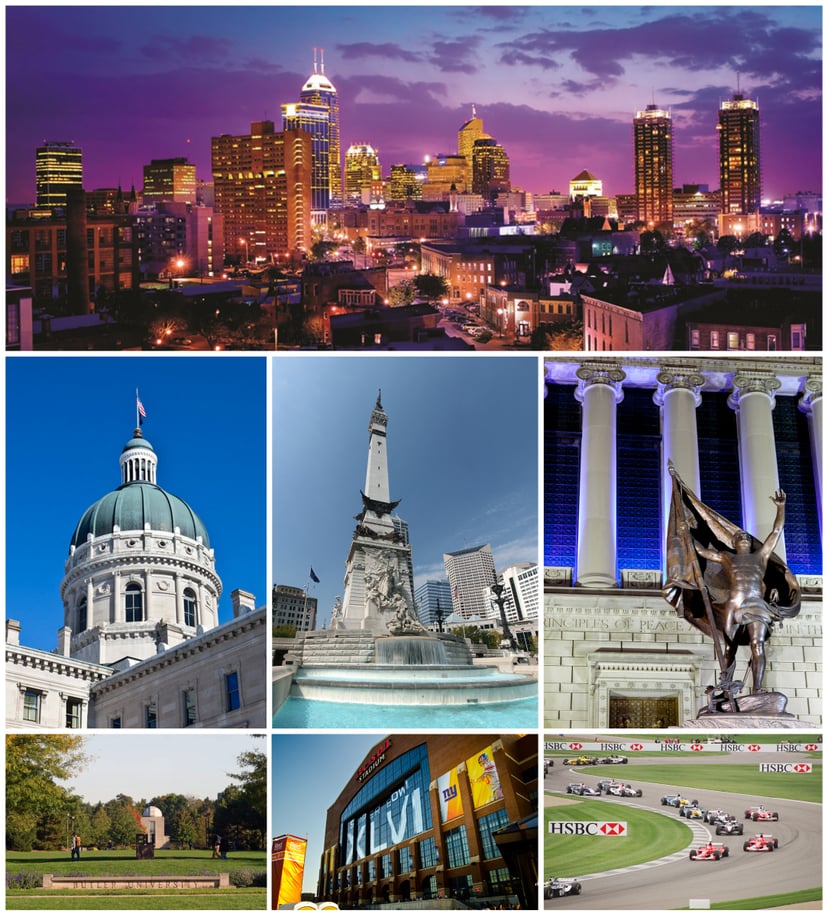
Indianapolis

Indianapolis | |
|---|---|
State capital and consolidated city-county | |
| City of Indianapolis and Marion County | |
| Nickname(s): "Indy"; "Circle City"; "Crossroads of America"; "Naptown"; "Amateur Sports Capital of the World"; "Railroad City"[5] | |
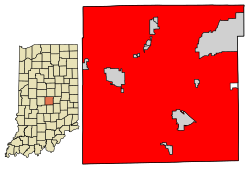 Location within Marion County | |
| Coordinates:39°46′07″N 86°09′29″W [378] | |
| Country | United States |
| State | Indiana |
| County | Marion |
| Founded | January 6, 1821[6] |
| Incorporated (town) | September 3, 1832[6] |
| Incorporated (city) | March 30, 1847[6] |
| City-county consolidation | January 1, 1970[7] |
| Government | |
| • Type | Strong mayor–council |
| • Body | Indianapolis City-County Council |
| • Mayor | Joe Hogsett (D) |
| Area | |
| • Land | 361.43 sq mi (936.1 km2) |
| • Water | 6.52 sq mi (16.9 km2) |
| Elevation | 715 ft (218 m) |
| Population | |
| • State capital and consolidated city-county | 820,445 |
| • Estimate (2018)[11] | 867,125 |
| • Rank | 16th in the United States |
| • Density | 2,269/sq mi (876/km2) |
| • Urban | 1,487,483 (US: 33rd) |
| • Metro | 2,004,230 (US: 34th) |
| • CSA | 2,386,199 (US: 27th) |
| Demonym(s) | Indianapolitan[12] |
| Time zone | UTC−5 (EST) |
| • Summer (DST) | UTC−4 (EDT) |
| ZIP Codes | 61 total ZIP codes:
|
| Area code(s) | 317 and 463 |
| FIPS code | 18-36003[13] |
| Website | www.indy.gov [379] |
Indianapolis (/ˌɪndiəˈnæpəlɪs/),[14][15][16] often shortened to Indy, is the state capital and most populous city of the U.S. state of Indiana and the seat of Marion County. According to 2017 estimates from the U.S. Census Bureau, the consolidated population of Indianapolis and Marion County was 872,680.[17] The "balance" population, which excludes semi-autonomous municipalities in Marion County, was 863,002.[18] It is the 17th most populous city in the U.S. The Indianapolis metropolitan area is the 34th most populous metropolitan statistical area in the U.S., with 2,028,614 residents.[19] Its combined statistical area ranks 27th, with a population of 2,411,086.[19] Indianapolis covers 368 square miles (950 km2), making it the 16th largest city by land area in the U.S.
Indigenous peoples inhabited the area dating to approximately 2000 BC. In 1818, the Delaware relinquished their tribal lands in the Treaty of St. Mary's.[20] In 1821, Indianapolis was founded as a planned city for the new seat of Indiana's state government. The city was platted by Alexander Ralston and Elias Pym Fordham on a 1-square-mile (2.6 km2) grid next to the White River. Completion of the National and Michigan roads and arrival of rail later solidified the city's position as a manufacturing and transportation hub.[21] Two of the city's nicknames reflect its historical ties to transportation—the "Crossroads of America" and "Railroad City".[22][23][5] Since the 1970 city-county consolidation, known as Unigov, local government administration operates under the direction of an elected 25-member city-county council headed by the mayor.
Indianapolis anchors the 27th largest economic region in the U.S., based primarily on the sectors of finance and insurance, manufacturing, professional and business services, education and health care, government, and wholesale trade.[24] The city has notable niche markets in amateur sports and auto racing.[25][26] The Fortune 500 companies of Anthem, Eli Lilly and Company, and Simon Property Group are headquartered in Indianapolis.[27] The city has hosted many international multi-sport events, such as the 1987 Pan American Games and 2001 World Police and Fire Games, but is perhaps best known for annually hosting the world's largest single-day sporting event, the Indianapolis 500.[28]
Indianapolis is home to two major league sports clubs, the Indiana Pacers of the National Basketball Association (NBA) and the Indianapolis Colts of the National Football League (NFL). It is home to a number of educational institutions, such as the University of Indianapolis, Butler University, Marian University, and Indiana University – Purdue University Indianapolis (IUPUI). The city's robust philanthropic community has supported several cultural assets, including the world's largest children's museum, one of the nation's largest privately funded zoos, historic buildings and sites, and public art.[29][30][31][32] The city is home to the largest collection of monuments dedicated to veterans and war casualties in the U.S. outside of Washington, D.C.[33][34]
Indianapolis | |
|---|---|
State capital and consolidated city-county | |
| City of Indianapolis and Marion County | |
| Nickname(s): "Indy"; "Circle City"; "Crossroads of America"; "Naptown"; "Amateur Sports Capital of the World"; "Railroad City"[5] | |
 Location within Marion County | |
| Coordinates:39°46′07″N 86°09′29″W [378] | |
| Country | United States |
| State | Indiana |
| County | Marion |
| Founded | January 6, 1821[6] |
| Incorporated (town) | September 3, 1832[6] |
| Incorporated (city) | March 30, 1847[6] |
| City-county consolidation | January 1, 1970[7] |
| Government | |
| • Type | Strong mayor–council |
| • Body | Indianapolis City-County Council |
| • Mayor | Joe Hogsett (D) |
| Area | |
| • Land | 361.43 sq mi (936.1 km2) |
| • Water | 6.52 sq mi (16.9 km2) |
| Elevation | 715 ft (218 m) |
| Population | |
| • State capital and consolidated city-county | 820,445 |
| • Estimate (2018)[11] | 867,125 |
| • Rank | 16th in the United States |
| • Density | 2,269/sq mi (876/km2) |
| • Urban | 1,487,483 (US: 33rd) |
| • Metro | 2,004,230 (US: 34th) |
| • CSA | 2,386,199 (US: 27th) |
| Demonym(s) | Indianapolitan[12] |
| Time zone | UTC−5 (EST) |
| • Summer (DST) | UTC−4 (EDT) |
| ZIP Codes | 61 total ZIP codes:
|
| Area code(s) | 317 and 463 |
| FIPS code | 18-36003[13] |
| Website | www.indy.gov [379] |
History
Etymology
The name Indianapolis is derived from the state's name, Indiana (meaning "Land of the Indians", or simply "Indian Land"[35]), and polis, the Greek word for city. Jeremiah Sullivan, justice of the Indiana Supreme Court, is credited with coining the name.[36] Other names considered were Concord, Suwarrow, and Tecumseh.[37]
Founding
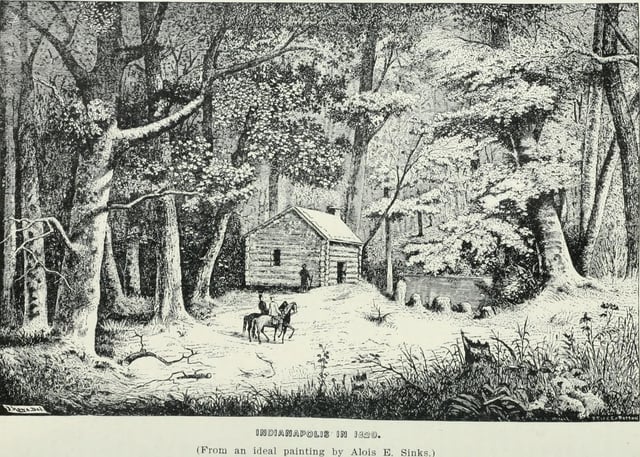
A depiction of 1820 Indianapolis.
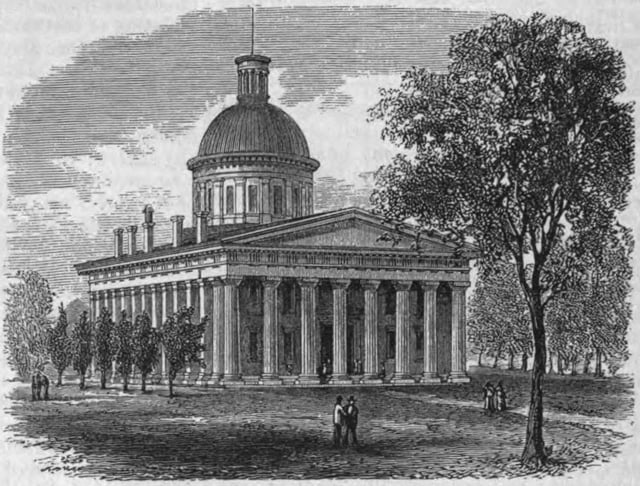
The Third Indiana Statehouse (1835–1877).
In 1816, the year Indiana gained statehood, the U.S. Congress donated four sections of federal land to establish a permanent seat of state government.[38] Two years later, under the Treaty of St. Mary's (1818), the Delaware relinquished title to their tribal lands in central Indiana, agreeing to leave the area by 1821.[20] This tract of land, which was called the New Purchase, included the site selected for the new state capital in 1820.[39]
The availability of new federal lands for purchase in central Indiana attracted settlers, many of them descendants of families from northwestern Europe. Although many of these first European and American settlers were Protestants, a large proportion of the early Irish and German immigrants were Catholics. Few African Americans lived in central Indiana before 1840.[40] The first European Americans to permanently settle in the area that became Indianapolis were either the McCormick or Pogue families. The McCormicks are generally considered to be the first permanent settlers; however, some historians believe George Pogue and family may have arrived first, on March 2, 1819, and settled in a log cabin along the creek that was later called Pogue's Run. Other historians have argued as early as 1822 that John Wesley McCormick, his family, and employees became the area's first European American settlers, settling near the White River in February 1820.[41]
On January 11, 1820, the Indiana General Assembly authorized a committee to select a site in central Indiana for the new state capital.[42] The state legislature approved the site, adopting the name Indianapolis on January 6, 1821.[6] In April, Alexander Ralston and Elias Pym Fordham were appointed to survey and design a town plan for the new settlement.[43] Indianapolis became a seat of county government on December 31, 1821, when Marion County, was established. A combined county and town government continued until 1832 when Indianapolis incorporated as a town. Indianapolis became an incorporated city effective March 30, 1847. Samuel Henderson, the city's first mayor, led the new city government, which included a seven-member city council. In 1853, voters approved a new city charter that provided for an elected mayor and a fourteen-member city council. The city charter continued to be revised as Indianapolis expanded.[44] Effective January 1, 1825, the seat of state government moved to Indianapolis from Corydon, Indiana. In addition to state government offices, a U.S. district court was established at Indianapolis in 1825.[45]
Growth occurred with the opening of the National Road through the town in 1827, the first major federally funded highway in the United States.[46] A small segment of the ultimately failed Indiana Central Canal was opened in 1839.[47] The first railroad to serve Indianapolis, the Jeffersonville, Madison and Indianapolis Railroad, began operation in 1847, and subsequent railroad connections fostered growth.[48] Indianapolis Union Station was the first of its kind in the world when it opened in 1853.[49]
Civil War and Gilded Age

Confederate POWs at Camp Morton in 1864.
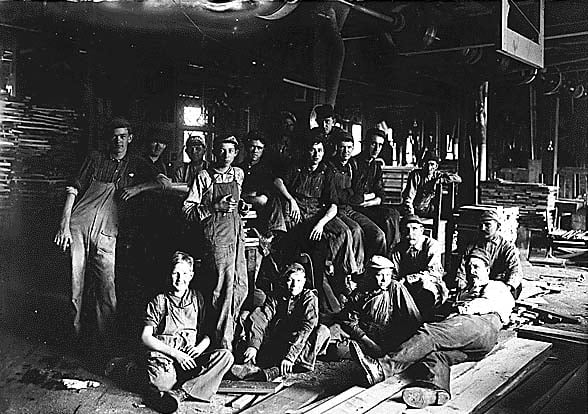
Child laborers in an Indianapolis furniture factory, 1908.
During the American Civil War, Indianapolis was mostly loyal to the Union cause. Governor Oliver P. Morton, a major supporter of President Abraham Lincoln, quickly made Indianapolis a rallying place for Union army troops. On February 11, 1861, president-elect Lincoln arrived in the city, en route to Washington, D.C. for his presidential inauguration, marking the first visit from a president-elect in the city's history.[50] On April 16, 1861, the first orders were issued to form Indiana's first regiments and establish Indianapolis as a headquarters for the state's volunteer soldiers.[51][52] Within a week, more than 12,000 recruits signed up to fight for the Union.[53]
Indianapolis became a major logistics hub during the war, establishing the city as a crucial military base.[54][55] Between 1860 and 1870, the city's population more than doubled.[48] An estimated 4,000 men from Indianapolis served in 39 regiments, and an estimated 700 died during the war.[56] On May 20, 1863, Union soldiers attempted to disrupt a statewide Democratic convention at Indianapolis, forcing the proceedings to be adjourned, sarcastically referred to as the Battle of Pogue's Run.[57] Fear turned to panic in July 1863, during Morgan's Raid into southern Indiana, but Confederate forces turned east toward Ohio, never reaching Indianapolis.[58] On April 30, 1865, Lincoln's funeral train made a stop at Indianapolis, where an estimated crowd of more than 100,000 people passed the assassinated president's bier at the Indiana Statehouse.[55][59]
Following the Civil War—and in the wake of the Second Industrial Revolution—Indianapolis experienced tremendous growth and prosperity. In 1880, Indianapolis was the world's third largest pork packing city, after Chicago and Cincinnati, and the second largest railroad center in the United States by 1888.[60][61] By 1890, the city's population surpassed 100,000.[48] Some of the city's most notable businesses were founded during this period of growth and innovation, including L. S. Ayres (1872), Eli Lilly and Company (1876), Madam C. J. Walker Manufacturing Company (1910), and Allison Transmission (1915). Once home to 60 automakers, Indianapolis rivaled Detroit as a center of automobile manufacturing.[62] The city was an early focus of labor organization.[48] The Indianapolis Street Car Strike of 1913 and subsequent police mutiny and riots led to the creation of the state's earliest labor-protection laws, including a minimum wage, regular work weeks, and improved working conditions.[63] The International Typographical Union and United Mine Workers of America were among several influential labor unions based in the city.[48]
Modern Indianapolis
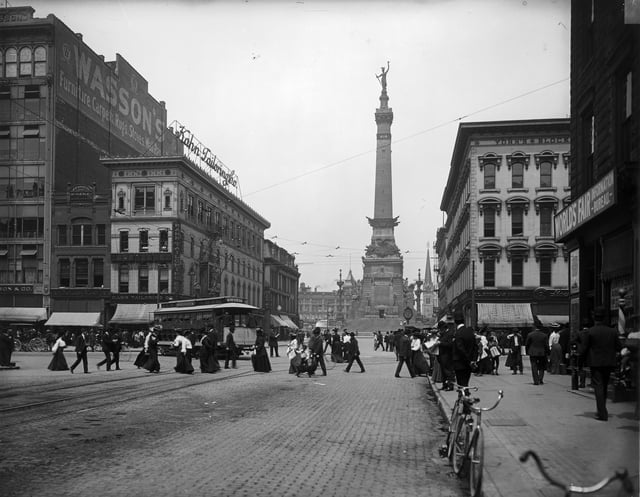
Meridian Street and Washington Street in 1904.
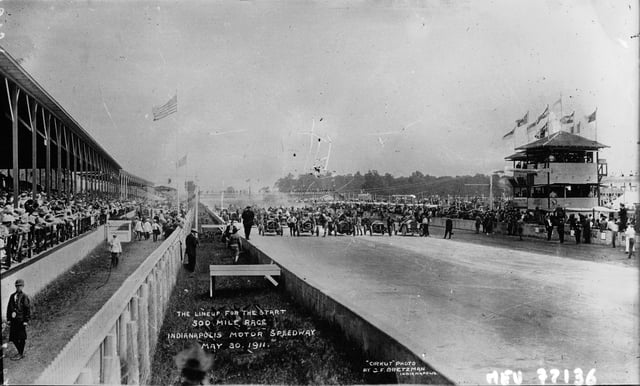
1911 Indianapolis 500, the inaugural running of the race.
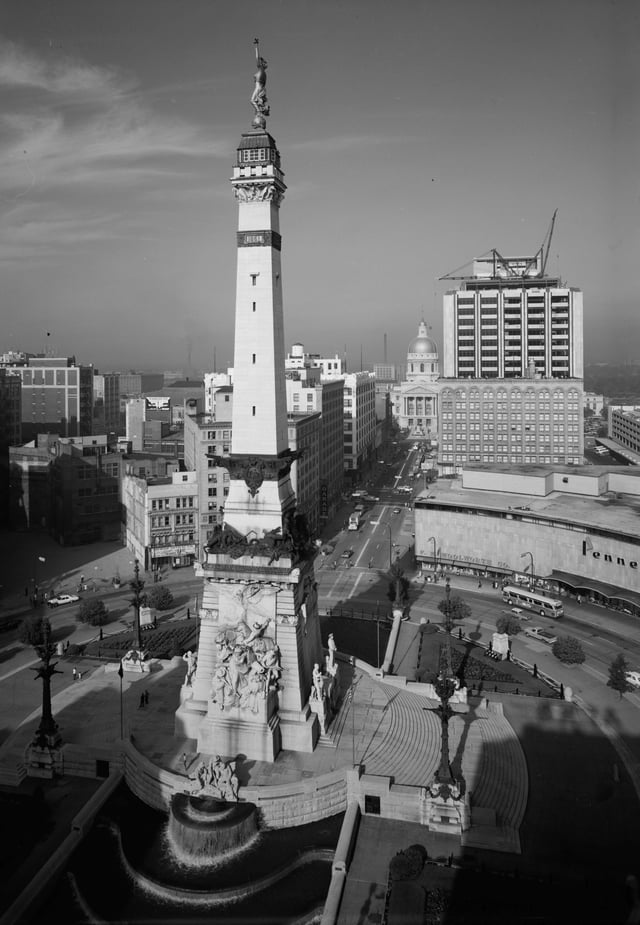
The Soldiers' and Sailors' Monument in 1970, the year Unigov was enacted.
Some of the city's most prominent architectural features and best known historical events date from the turn of the 20th century. The Soldiers' and Sailors' Monument, dedicated on May 15, 1902, would later become the city's unofficial symbol.[64] Ray Harroun won the inaugural running of the Indianapolis 500, held May 30, 1911, at Indianapolis Motor Speedway. Indianapolis was one of the hardest hit cities in the Great Flood of 1913, resulting in five known deaths[65][66][67] and the displacement of 7,000 families.[68]
As a stop on the Underground Railroad, Indianapolis had a higher black population than any other city in the Northern States, until the Great Migration.[69] Led by D. C. Stephenson, the Indiana Klan became the most powerful political and social organization in Indianapolis from 1921 through 1928, controlling City Council and the Board of School Commissioners, among others. At its height, more than 40% of native-born white males in Indianapolis claimed membership in the Klan. While campaigning in the city in 1968, Robert F. Kennedy delivered one of the most lauded speeches in 20th century American history, following the assassination of civil rights leader Martin Luther King Jr.[70][71][72] As in most U.S. cities during the Civil Rights Movement, the city experienced strained race relations. A 1971 federal court decision forcing Indianapolis Public Schools to implement desegregation busing proved controversial.[73]
Under the mayoral administration of Richard Lugar, the city and county governments restructured, consolidating most public services into a new entity called Unigov. The plan removed bureaucratic redundancies, captured increasingly suburbanizing tax revenue, and created a Republican political machine that dominated Indianapolis politics until the 2000s decade.[74][75] Unigov went into effect on January 1, 1970, increasing the city's land area by 308.2 square miles (798 km2) and population by 268,366 people.[76][77] It was the first major city-county consolidation to occur in the United States without a referendum since the creation of the City of Greater New York in 1898.[78]
Amid the changes in government and growth, the city invested in an aggressive strategy to brand Indianapolis as a sports tourism destination. Under the administration of the city's longest-serving mayor, William Hudnut (1976–1992), millions of dollars were poured into sport facilities.[26] Throughout the 1980s, $122 million in public and private funding built the Indianapolis Tennis Center, Major Taylor Velodrome, Indiana University Natatorium, Carroll Track and Soccer Stadium, and Hoosier Dome.[26] The latter project secured the 1984 relocation of the NFL Baltimore Colts and the 1987 Pan American Games.[26] The economic development strategy succeeded in revitalizing the central business district through the 1990s, with the openings of the Indianapolis Zoo, Canal Walk,[47] Circle Centre Mall, Victory Field, and Bankers Life Fieldhouse.
During the 2000s, the city continued investing heavily in infrastructure projects, including two of the largest building projects in the city's history: the $1.1 billion Col. H. Weir Cook Terminal and $720 million Lucas Oil Stadium, both opened in 2008.[79][80] A $275 million expansion of the Indiana Convention Center was completed in 2011.[81] Construction began that year on DigIndy, a $1.9 billion project to correct the city's combined sewer overflows (CSOs) by 2025.[82]
Geography
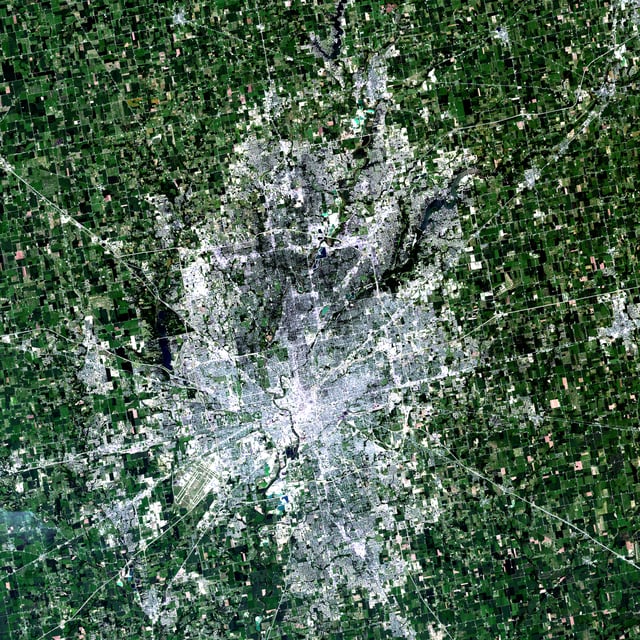
Landsat simulated-color image of the Indianapolis metropolitan area.
Indianapolis is in the East North Central region of the Midwestern United States, in central Indiana. According to the U.S. Census Bureau, the Indianapolis (balance) encompasses a total area of 368.2 square miles (954 km2), of which 361.5 square miles (936 km2) is land and 6.7 square miles (17 km2) is water. The consolidated city boundaries are coterminous with Marion County, with the exception of the autonomous municipalities of Beech Grove, Lawrence, Southport, and Speedway.[48][83] Indianapolis is the 16th largest city by land area in the U.S.
Indianapolis is within the Tipton Till Plain, a flat to gently sloping terrain underlain by glacial deposits known as till.[84] The lowest point in the city is about 650 feet (198 m) above mean sea level, with the highest natural elevation at about 900 feet (274 m) above sea level.[84] Few hills or short ridges, known as kames, rise about 100 feet (30 m) to 130 feet (40 m) above the surrounding terrain.[84] The city lies just north of the Indiana Uplands, a region characterized by rolling hills and high limestone content. The city is also within the EPA's Eastern Corn Belt Plains ecoregion, an area of the U.S. known for its fertile agricultural land.[85]
Topographic relief slopes gently toward the White River and its two primary tributaries, Fall and Eagle creeks. In total, there are about 35 streams in the city, including Indian Creek and Pogue's Run.[86] Major bodies of water include Indian Lake, Geist Reservoir, and Eagle Creek Reservoir.
Cityscape

Panorama of the downtown Indianapolis skyline in 2016.
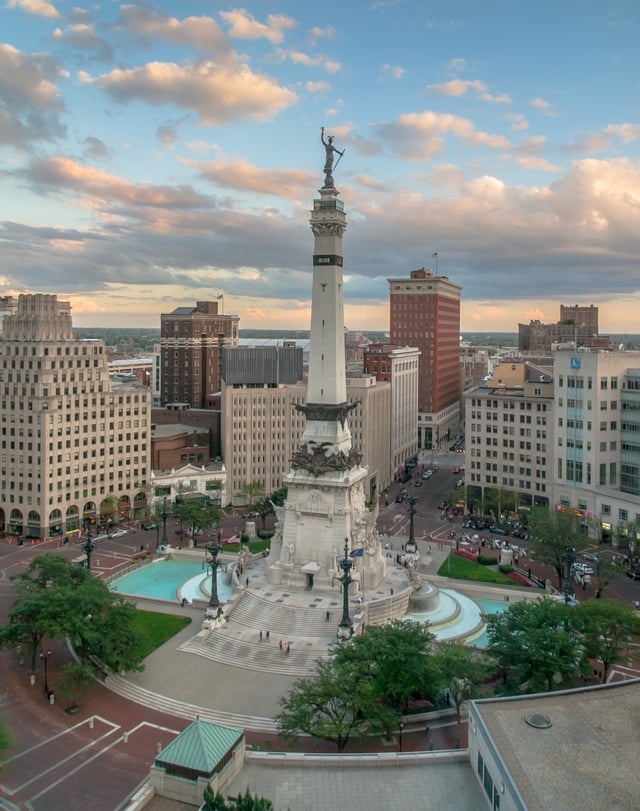
The Soldiers' and Sailors' Monument was dedicated in 1902.
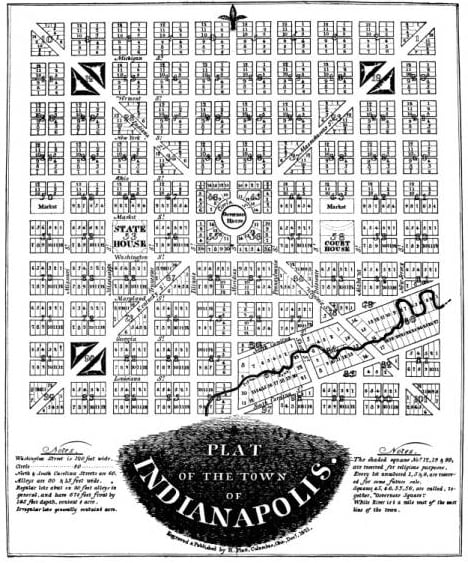
Alexander Ralston's "Plat of the Town of Indianapolis," today known as the Mile Square.
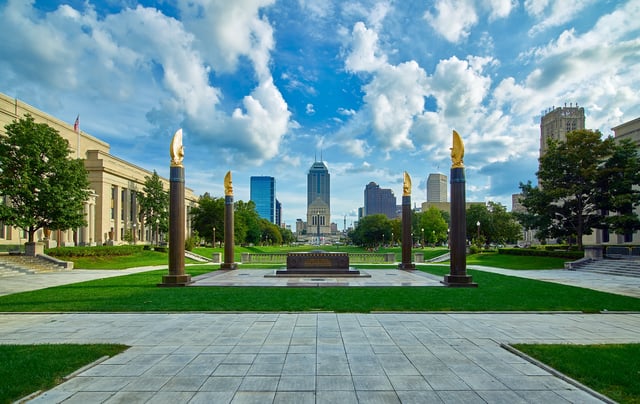
The Indiana World War Memorial Plaza Historic District includes the American Legion (left) and Scottish Rite Cathedral (right).
Indianapolis is a planned city. On January 11, 1820, the Indiana General Assembly authorized a committee to select a site in central Indiana for the new state capital, appointing Alexander Ralston and Elias Pym Fordham to survey and design a town plan for Indianapolis. Ralston had been a surveyor for the French architect Pierre L'Enfant, assisting him with the plan for Washington, D.C. Ralston's original plan for Indianapolis called for a town of 1 square mile (2.6 km2), near the confluence of the White River and Fall Creek.[87]
The plan, known as the Mile Square, is bounded by East, West, North, and South streets, centered on a traffic circle, called Monument Circle (originally Governor's Circle), from which Indianapolis's "Circle City" nickname originated.[88] Four diagonal streets radiated a block from Monument Circle: Massachusetts, Virginia, Kentucky, and Indiana avenues.[89] The city's address numbering system begins at the intersection of Washington and Meridian streets.[90] Before its submersion into a sanitary tunnel, Pogue's Run was included into the plan, disrupting the rectilinear street grid to the southeast.
Noted as one of the finest examples of the City Beautiful movement design in the United States, the Indiana World War Memorial Plaza Historic District began construction in 1921 in downtown Indianapolis.[91][92] The district, a National Historic Landmark, encompasses several examples of neoclassical architecture, including the American Legion, Central Library, and Birch Bayh Federal Building and United States Courthouse. The district is also home to several sculptures and memorials, Depew Memorial Fountain, and open space, hosting many annual civic events.[92]
After completion of the Soldiers' and Sailors' Monument, an ordinance was passed in 1905 restricting building heights on the traffic circle to 86 ft (26 m) to protect views of the 284 ft (87 m) monument.[93] The ordinance was revised in 1922, permitting buildings to rise to 108 ft (33 m), with an additional 42 ft (13 m) allowable with a series of setbacks.[93] A citywide height restriction ordinance was instituted in 1912, barring structures over 200 ft (61 m).[94] Completed in 1962, the City-County Building was the first skyscraper in the city, surpassing the Soldiers' and Sailors' Monument in height by nearly 100 ft (30 m).[95] A building boom, lasting from 1982 to 1990, saw the construction of six of the city's ten tallest buildings.[96][97] The tallest is Salesforce Tower, completed in 1990 at 811 ft (247 m).[98] Indiana limestone is the signature building material in Indianapolis, widely included in the city's many monuments, churches, academic, government, and civic buildings.[96]
Compared with similar-sized American cities, Indianapolis is unique in that it contains some 200 farms covering thousands of acres of agricultural land within its municipal boundaries.[99] Equestrian farms and corn and soybean fields interspersed with suburban development are commonplace on the city's periphery, especially in Franklin Township. The stark contrast between Indianapolis's urban neighborhoods and rural villages is a result of the 1970 city-county consolidation, which expanded the city's incorporated boundary to be coterminous with Marion County.[100]
Neighborhoods
The city is divided into 99 community areas for statistical purposes, though many smaller neighborhoods exist within them.[101] Indianapolis's neighborhoods are often difficult to define because the city lacks historical ethnic divisions, as in Chicago, or physical boundaries, seen in Pittsburgh and Cincinnati.[102] Instead, most neighborhoods are subtle in their distinctions.[102] The Indianapolis Historic Preservation Commission recognizes several neighborhoods as historic districts, including: Central Court, Chatham Arch, Golden Hill, Herron-Morton Place, Lockerbie Square, Old Northside, Old Southside and Oliver Johnson's Woods. Expansion of the interurban system at the turn of the 20th century facilitated growth of several streetcar suburbs, including Broad Ripple, Irvington, University Heights, and Woodruff Place.[102]
The post–World War II economic expansion and subsequent suburbanization had a profound impact on the physical development of the city's neighborhoods. From 1950 to 1970, 97,000 housing units were built in Marion County.[102] Most of this new construction occurred outside Center Township, expediting out-migration from the city's urban neighborhoods to suburban areas, such as Castleton, Eagledale, and Nora. Between 1950 and 1990, over 155,000 residents left Center Township, resulting in urban blight and disinvestment.[102] Since the 2000s, Downtown Indianapolis and surrounding neighborhoods have seen increased reinvestment attributed to nationwide demographic trends, driven by empty nesters and millennials.[103] By 2020, Downtown is projected to have 30,000 residential units, compared to 18,300 in 2010.[104]
Renewed interest in urban living has been met with some dispute regarding gentrification and affordable housing.[105][106][107] According to a Center for Community Progress report, neighborhoods like Cottage Home and Fall Creek Place have experienced measurable gentrification since 2000.[108] The North Meridian Street Historic District is among the most affluent urban neighborhoods in the U.S., with a mean household income of $102,599 in 2017.[109]
Climate
Typically, summers are hot, humid and wet. Winters are generally cold with moderate snowfall. The July daily average temperature is 75.4 °F (24.1 °C). High temperatures reach or exceed 90 °F (32 °C) an average of 18 days each year,[112] and occasionally exceed 95 °F (35 °C). Spring and autumn are usually pleasant, if at times unpredictable; midday temperature drops exceeding 30 °F or 17 °C are common during March and April, and instances of very warm days (80 °F or 27 °C) followed within 36 hours by snowfall are not unusual during these months. Winters are cold, with an average January temperature of 28.1 °F (−2.2 °C). Temperatures dip to 0 °F (−18 °C) or below an average of 4.7 nights per year.[112]
The rainiest months occur in the spring and summer, with slightly higher averages during May, June, and July. May is typically the wettest, with an average of 5.05 inches (12.8 cm) of precipitation.[112] Most rain is derived from thunderstorm activity; there is no distinct dry season, although occasional droughts occur. Severe weather is not uncommon, particularly in the spring and summer months; the city experiences an average of 20 thunderstorm days annually.[113]
| Climate data for Indianapolis (Indianapolis International Airport), 1981–2010 normals,[1] extremes 1871–present[2] | |||||||||||||
|---|---|---|---|---|---|---|---|---|---|---|---|---|---|
| Month | Jan | Feb | Mar | Apr | May | Jun | Jul | Aug | Sep | Oct | Nov | Dec | Year |
| Record high °F (°C) | 71 (22) | 77 (25) | 85 (29) | 90 (32) | 96 (36) | 104 (40) | 106 (41) | 103 (39) | 100 (38) | 91 (33) | 81 (27) | 74 (23) | 106 (41) |
| Mean maximum °F (°C) | 58.3 (14.6) | 63.3 (17.4) | 75.3 (24.1) | 81.4 (27.4) | 86.2 (30.1) | 91.9 (33.3) | 93.6 (34.2) | 92.5 (33.6) | 89.8 (32.1) | 82.1 (27.8) | 71.3 (21.8) | 59.8 (15.4) | 94.8 (34.9) |
| Average high °F (°C) | 35.6 (2.0) | 40.2 (4.6) | 51.7 (10.9) | 63.4 (17.4) | 72.8 (22.7) | 81.9 (27.7) | 85.0 (29.4) | 84.0 (28.9) | 77.6 (25.3) | 65.3 (18.5) | 52.2 (11.2) | 38.9 (3.8) | 62.4 (16.9) |
| Daily mean °F (°C) | 28.1 (−2.2) | 32.1 (0.1) | 42.2 (5.7) | 53.0 (11.7) | 62.7 (17.1) | 72.0 (22.2) | 75.4 (24.1) | 74.2 (23.4) | 66.9 (19.4) | 55.0 (12.8) | 43.6 (6.4) | 31.6 (−0.2) | 53.1 (11.7) |
| Average low °F (°C) | 20.5 (−6.4) | 23.9 (−4.5) | 32.8 (0.4) | 42.7 (5.9) | 52.6 (11.4) | 62.1 (16.7) | 65.8 (18.8) | 64.4 (18.0) | 56.2 (13.4) | 44.7 (7.1) | 35.1 (1.7) | 24.4 (−4.2) | 43.8 (6.6) |
| Mean minimum °F (°C) | −2.5 (−19.2) | 3.4 (−15.9) | 14.9 (−9.5) | 26.6 (−3.0) | 37.7 (3.2) | 48.2 (9.0) | 55.0 (12.8) | 53.8 (12.1) | 40.6 (4.8) | 29.6 (−1.3) | 20.0 (−6.7) | 3.3 (−15.9) | −7.8 (−22.1) |
| Record low °F (°C) | −27 (−33) | −21 (−29) | −7 (−22) | 18 (−8) | 28 (−2) | 37 (3) | 46 (8) | 41 (5) | 30 (−1) | 20 (−7) | −5 (−21) | −23 (−31) | −27 (−33) |
| Average precipitation inches (mm) | 2.66 (68) | 2.32 (59) | 3.56 (90) | 3.81 (97) | 5.05 (128) | 4.25 (108) | 4.55 (116) | 3.13 (80) | 3.12 (79) | 3.12 (79) | 3.70 (94) | 3.17 (81) | 42.44 (1,078) |
| Average snowfall inches (cm) | 8.6 (22) | 6.5 (17) | 2.6 (6.6) | 0.2 (0.51) | trace | 0 (0) | 0 (0) | 0 (0) | 0 (0) | 0.4 (1.0) | 0.7 (1.8) | 6.9 (18) | 25.9 (66) |
| Average precipitation days(≥ 0.01 in) | 12.1 | 10.0 | 11.9 | 12.0 | 13.1 | 11.1 | 10.5 | 8.5 | 8.1 | 8.6 | 10.8 | 12.5 | 129.2 |
| Average snowy days(≥ 0.1 in) | 7.5 | 5.4 | 2.5 | 0.4 | 0 | 0 | 0 | 0 | 0 | 0.2 | 1.2 | 6.3 | 23.5 |
| Average relative humidity (%) | 75.0 | 73.6 | 69.9 | 65.6 | 67.1 | 68.4 | 72.8 | 75.4 | 74.4 | 71.6 | 75.5 | 78.0 | 72.3 |
| Mean monthly sunshine hours | 132.1 | 145.7 | 178.3 | 214.8 | 264.7 | 287.2 | 295.2 | 273.7 | 232.6 | 196.6 | 117.1 | 102.4 | 2,440.4 |
| Percent possible sunshine | 44 | 49 | 48 | 54 | 59 | 64 | 65 | 64 | 62 | 57 | 39 | 35 | 55 |
| Average ultraviolet index | 2 | 3 | 4 | 6 | 8 | 9 | 9 | 8 | 6 | 4 | 2 | 2 | 5 |
| Source: NOAA (relative humidity and sun 1961–1990)[112][116][117] | |||||||||||||
Demographics
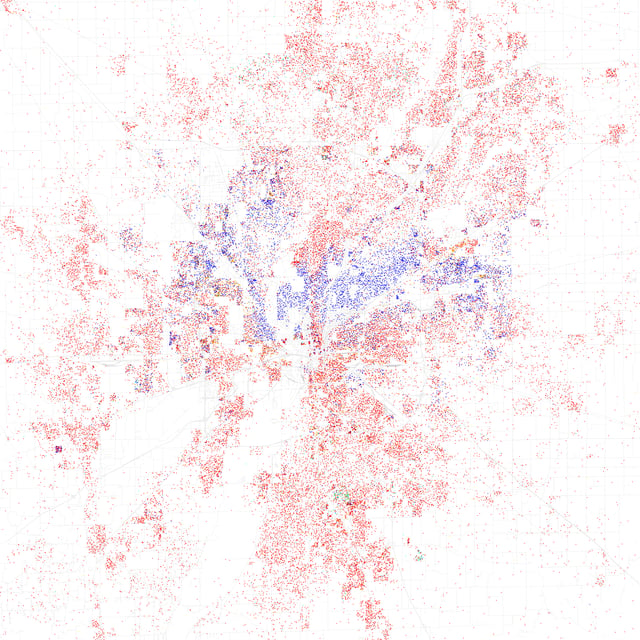
Map of racial distribution in Indianapolis, 2010 U.S. Census. Each dot is 25 people: White, Black, Asian, Hispanic or Other (yellow)
| Historical population | |||
|---|---|---|---|
| Census | Pop. | %± | |
| 1840 | 2,695 | — | |
| 1850 | 8,091 | 200.2% | |
| 1860 | 18,611 | 130.0% | |
| 1870 | 48,244 | 159.2% | |
| 1880 | 75,056 | 55.6% | |
| 1890 | 105,436 | 40.5% | |
| 1900 | 169,164 | 60.4% | |
| 1910 | 233,650 | 38.1% | |
| 1920 | 314,194 | 34.5% | |
| 1930 | 364,161 | 15.9% | |
| 1940 | 386,972 | 6.3% | |
| 1950 | 427,173 | 10.4% | |
| 1960 | 476,258 | 11.5% | |
| 1970 | 744,624 | 56.3% | |
| 1980 | 700,807 | −5.9% | |
| 1990 | 731,327 | 4.4% | |
| 2000 | 781,926 | 6.9% | |
| 2010 | 820,445 | 4.9% | |
| Est. 2018 | 867,125 | [11] | 5.7% |
| [9][118][119] | |||
The U.S. Census Bureau considers Indianapolis as two entities: the consolidated city and the city's remainder, or balance. The consolidated city is coterminous with Marion County, except the independent municipalities of Beech Grove, Lawrence, Southport, and Speedway.[124] The city's balance excludes the populations of ten semi-autonomous municipalities that are included in totals for the consolidated city.[83] These are Clermont, Crows Nest, Homecroft, Meridian Hills, North Crows Nest, Rocky Ripple, Spring Hill, Warren Park, Williams Creek, and Wynnedale.[124][7] An eleventh town, Cumberland, is partially included.[125][126] As of 2017, the city's estimated consolidated population was 872,680 and its balance was 863,002.[17][18] As of 2010, the city's population density was 2,270 people per square mile (880/km2).[127] Indianapolis is the most populous city in Indiana, containing nearly 13% of the state's total population.[83]
The Indianapolis metropolitan area, officially the Indianapolis–Carmel–Anderson metropolitan statistical area (MSA), consists of Marion County and the surrounding counties of Boone, Brown, Hamilton, Hancock, Hendricks, Johnson, Madison, Morgan, Putnam, and Shelby. As of 2017, the metropolitan area's population was 2,028,614, the most populous in Indiana and home to 30% of the state's residents.[128] With a population of 2,411,086, the larger Indianapolis–Carmel–Muncie combined statistical area (CSA) covers 18 counties, home to 36% of Indiana residents.[129] Indianapolis is also situated within the Great Lakes Megalopolis, the largest of 11 megaregions in the U.S.
According to the U.S. Census of 2010, 97.2% of the Indianapolis population was reported as one race: 61.8% White, 27.5% Black or African American, 2.1% Asian (0.4% Burmese, 0.4% Indian, 0.3% Chinese, 0.3% Filipino, 0.1% Korean, 0.1% Vietnamese, 0.1% Japanese, 0.1% Thai, 0.1% other Asian); 0.3% American Indian, and 5.5% as other. The remaining 2.8% of the population was reported as multiracial (two or more races).[130] The city's Hispanic or Latino community comprised 9.4% of the city's population in the 2010 U.S. Census: 6.9% Mexican, 0.4% Puerto Rican, 0.1% Cuban, and 2% as other.[130]
As of 2010, the median age for Indianapolis was 33.7 years. Age distribution for the city's inhabitants was 25% under the age of 18; 4.4% were between 18 and 21; 16.3% were age 21 to 65; and 13.1% were age 65 or older.[130] For every 100 females, there were 93 males. For every 100 females age 18 and over, there were 90 males.[131]
The U.S. Census for 2010 reported 332,199 households in Indianapolis, with an average household size of 2.42 and an average family size of 3.08.[130] Of the total households, 59.3% were family households, with 28.2% of these including the family's own children under the age of 18; 36.5% were husband-wife families; 17.2% had a female householder (with no husband present) and 5.6% had a male householder (with no wife present). The remaining 40.7% were non-family households.[130] As of 2010, 32% of the non-family households included individuals living alone, 8.3% of these households included individuals age 65 years of age or older.[130]
The U.S. Census Bureau's 2007–2011 American Community Survey indicated the median household income for Indianapolis city was $42,704, and the median family income was $53,161.[132] Median income for males working full-time, year-round, was $42,101, compared to $34,788 for females. Per capita income for the city was $24,430, 14.7% of families and 18.9% of the city's total population living below the poverty line (28.3% were under the age of 18 and 9.2% were age 65 or older).[132]
As of 2015, the Indianapolis metropolitan area had the 18th highest percentage of LGBT residents in the U.S., with 4.2% of residents identifying as gay, lesbian, bisexual, or transgender.[133]
Religion
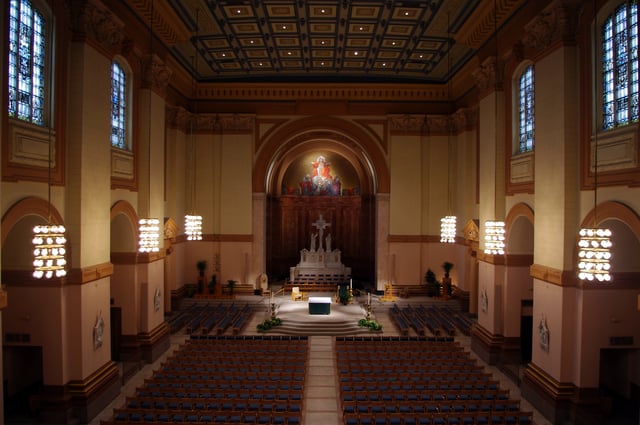
Interior of Saints Peter and Paul Cathedral, head church of the Roman Catholic Archdiocese of Indianapolis.
Of the 42.42% of the city's residents who identify as religious, Roman Catholics make up the largest group, at 11.31%.[134] The second highest religious group in the city are Baptists at 10.31%, with Methodists following behind at 4.97%. Presbyterians make up 2.13% of the city's religiously affiliated population, followed by Pentecostals and Lutherans. Another 8.57% are affiliated with other Christian faiths.[134] 0.32% of religiously affiliated persons identified themselves as following Eastern religions, while 0.68% of the religiously affiliated population identified as Jewish, and 0.29% as Muslim.[134] According to the nonpartisan and nonprofit Public Religion Research Institute's American Values Atlas, 22% of residents identify as religiously "unaffiliated," consistent with the national average of 22.7%.[135]
Indianapolis is the seat of the Roman Catholic Archdiocese of Indianapolis. Joseph W. Tobin, C.Ss.R., served as archbishop from 2012 to 2017 and was elevated to cardinal in November 2016. On June 13, 2017, Pope Francis announced Charles C. Thompson would replace Tobin, who was reassigned to the Roman Catholic Archdiocese of Newark in January 2017.[136] Thompson is the youngest American archbishop.[137] The archdiocese also operates Bishop Simon Bruté College Seminary, affiliated with Marian University, while the Christian Theological Seminary is affiliated with the Christian Church (Disciples of Christ).
Indianapolis is the seat of the Episcopal Diocese of Indianapolis, based from Christ Church Cathedral. The Indiana-Kentucky Synod of the Evangelical Lutheran Church in America and the Indiana Conference of the United Methodist Church are also based in the city.
Economy
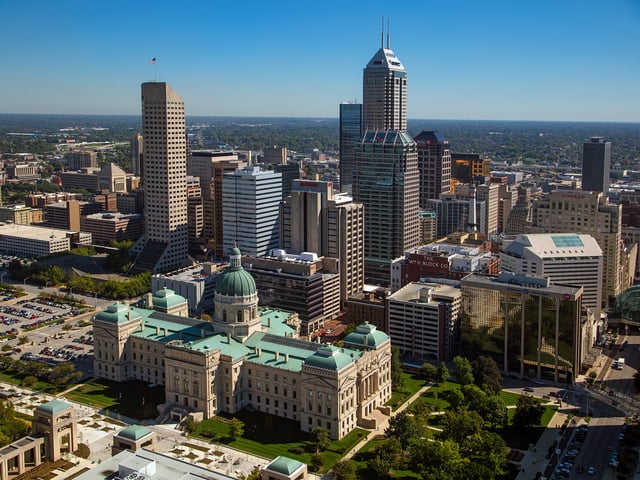
Downtown Indianapolis is the largest employment cluster in Indiana, with nearly 43,000 jobs per square mile (17,000/km2).[138]
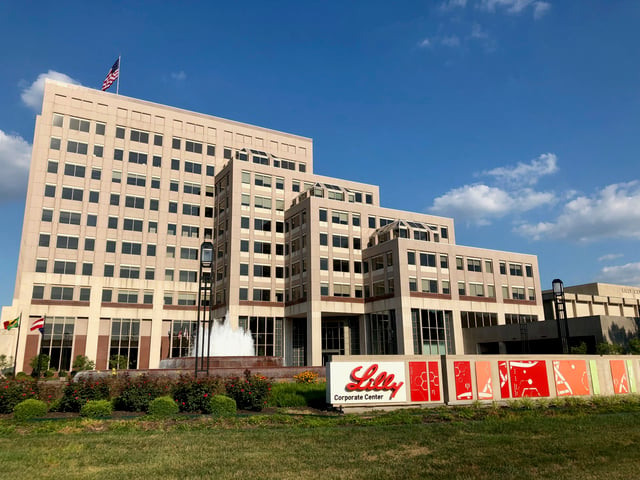
Indianapolis-based Eli Lilly and Company is the city's largest employer.
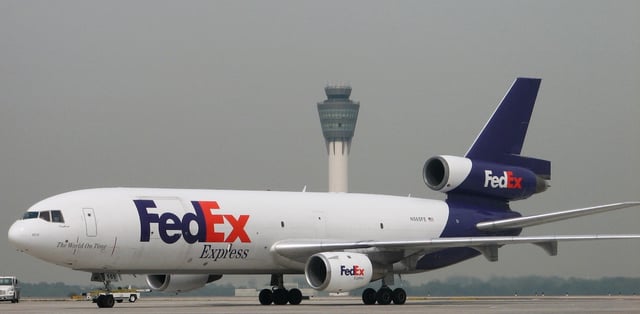
FedEx Express cargo plane at Indianapolis International Airport.
In 2015, the Indianapolis metropolitan area had a gross domestic product (GDP) of $134 billion. The top five industries were: finance, insurance, real estate, rental, and leasing ($30.7B), manufacturing ($30.1B), professional and business services ($14.3B), educational services, health care, and social assistance ($10.8B), and wholesale trade ($8.1B). Government, if it had been a private industry, would have ranked fifth, generating $10.2 billion.[24] Indianapolis is considered a "sufficiency" world city.[139]
Compared to Indiana as a whole, the Indianapolis metropolitan area has a lower proportion of manufacturing jobs and a higher concentration of jobs in wholesale trade; administrative, support, and waste management; professional, scientific, and technical services; and transportation and warehousing.[140] The city's major exports include pharmaceuticals, motor vehicle parts, medical equipment and supplies, engine and power equipment, and aircraft products and parts.[22] According to the Bureau of Labor Statistics, the region's unemployment rate was 2.8 percent in May 2019.[141]
As of 2019, three Fortune 500 companies were based in the city: health insurance company Anthem Inc. (33);[142] pharmaceutical company Eli Lilly (123);[143] and Simon Property Group (496), the largest real estate investment trust in the U.S.[144] Columbus, Indiana-based Cummins (128) opened its Global Distribution Headquarters in downtown Indianapolis in 2017.[145][146] The city is home to three Fortune 1000 companies: hydrocarbon manufacturer Calumet Specialty Products Partners (604); automotive transmission manufacturer Allison Transmission (890); and retailer Finish Line (972). Other companies based in the Indianapolis metropolitan area include: real estate investment trust Duke Realty;[147] media conglomerate Emmis Communications;[148] retailer Lids;[149] financial services holding company OneAmerica;[150] airline holding company Republic Airways;[151] truckload carrier Celadon Group;[152] and fast food chains Noble Roman's and Steak 'n Shake.
Like many Midwestern cities, recent deindustrialization trends have had a significant impact on the local economy. Once home to 60 automakers, Indianapolis rivaled Detroit as a center of automobile manufacturing in the early 20th century.[62] Between 1990 and 2012, approximately 26,900 manufacturing jobs were lost in the city, including the automotive plant closures of Chrysler, Ford, and General Motors.[153] In 2016, Carrier Corporation announced the closure of its Indianapolis plant, moving 1,400 manufacturing jobs to Mexico.[154] Since 1915, Rolls-Royce Holdings has had operations in Indianapolis.[155] It is the third largest manufacturing employer and thirteenth largest employer overall in the city, with a workforce of 4,300 in aircraft engine development and manufacturing.[156]
Biotechnology, life sciences and health care are major sectors of Indianapolis's economy. As of 2016, Eli Lilly and Company was the largest private employer in the city, with more than 11,000 workers.[157] The North American headquarters for Roche Diagnostics and Dow AgroSciences are also in the city.[158] A 2014 report by the Battelle Memorial Institute and Biotechnology Industry Organization indicated that the Indianapolis–Carmel–Anderson MSA was the only U.S. metropolitan area to have specialized employment concentrations in all five bioscience sectors evaluated in the study: agricultural feedstock and chemicals; bioscience-related distribution; drugs and pharmaceuticals; medical devices and equipment; and research, testing, and medical laboratories.[159] The regional health care providers of Community Health Network, Eskenazi Health, Franciscan Health, Indiana University Health, and St. Vincent Health have a combined workforce of 43,700.[160]
The city's central location and extensive highway and rail infrastructure have positioned Indianapolis as an important logistics center, home to 1,500 distribution firms employing some 100,000 workers.[161][162][163] As home to the second largest FedEx Express hub in the world, Indianapolis International Airport ranks as the sixth busiest U.S. airport in terms of air cargo transport, handling over 1 million tons and employing 6,600 in 2015.[164][165] Indianapolis is a hub for CSX Transportation, home to its division headquarters, an intermodal terminal, and classification yard (in the suburb of Avon).[166] Amtrak's Beech Grove Shops, in the enclave of Beech Grove, serve as its primary heavy maintenance and overhaul facility, while the Indianapolis Distribution Center is the company's largest material and supply terminal.[167][168]
The hospitality industry is an increasingly vital sector to the Indianapolis economy. According to Visit Indy, 28.8 million visitors generated $5.4 billion in 2017, the seventh straight year of record growth.[169] Indianapolis has long been a sports tourism destination, but has more recently relied on conventions.[170] The Indiana Convention Center (ICC) and Lucas Oil Stadium are considered mega convention center facilities, with a combined 750,000 square feet (70,000 m2) of exhibition space.[171] ICC is connected to 12 hotels and 4,700 hotel rooms, the most of any U.S. convention center.[172] In 2008, the facility hosted 42 national conventions with an attendance of 317,815; in 2014, it hosted 106 for an attendance of 635,701.[170] Since 2003, Indianapolis has hosted Gen Con, one of the largest gaming conventions in North America.[173]
According to real estate tracking firm CBRE Group, Indianapolis ranks among the fastest high-tech job growth areas in the U.S.[174][175] The metropolitan area is home to 28,500 information technology-related jobs at such companies as Angie's List, Appirio, Formstack, Genesys, Infosys,[176] Ingram Micro, and Salesforce Marketing Cloud.[177][178]
Major shopping malls in the city include Castleton Square, Circle Centre, The Fashion Mall at Keystone, Glendale Town Center, Lafayette Square, and Washington Square.
Culture and contemporary life

Part of the "Month of May" celebrations, the 500 Festival Parade is one of the nation's largest, regularly drawing 300,000 spectators.[179]
In 1999, Indianapolis designated six cultural districts to capitalize on cultural institutions within historically significant neighborhoods unique to the city's heritage. These include Broad Ripple Village, Canal and White River State Park, Fountain Square, Indiana Avenue, Mass Ave, and Wholesale.[180] A seventh cultural district, Market East, was designated in 2014.[181]
After 12 years of planning and six years of construction, the Indianapolis Cultural Trail officially opened in 2013.[182] The $62.5 million public-private partnership, spurred by an initial donation of $15 million by philanthropists Gene B. Glick and Marilyn Glick, resulted in 8 miles (13 km) of urban bike and pedestrian corridors linking the city's cultural districts with neighborhoods, IUPUI, and every significant arts, cultural, heritage, sports and entertainment venue downtown.[183][184][185][186][187]
Indianapolis is home to dozens of annual festivals and events showcasing local culture. Notable events include the "Month of May" (a series of celebrations leading to the Indianapolis 500), Indiana Black Expo, Indiana State Fair, Indy Pride Festival, and Historic Irvington Halloween Festival.
Visual arts

Robert Indiana's iconic LOVE at the Indianapolis Museum of Art.

October Suite: Grand Canyon by Wilson Hurley at the Eiteljorg Museum of American Indians and Western Art.
Founded in 1883, the Indianapolis Museum of Art (IMA) is the ninth oldest[188][3] and eighth largest encyclopedic art museum in the U.S.[190][4] The permanent collection has over 54,000 works, including African, American, Asian, and European pieces.[191] In addition to its collections, the Newfields campus consists of The Virginia B. Fairbanks Art & Nature Park: 100 Acres; Oldfields, a restored house museum and estate once owned by Josiah K. Lilly, Jr.; and restored gardens and grounds originally designed by Percival Gallagher of the Olmsted Brothers firm.[192] The IMA also owns the Miller House, a Mid-century modern home designed by Eero Saarinen in Columbus, Indiana.[193] The museum's holdings demonstrate the institution's emphasis on the connections among art, design, and the natural environment.[189]
The Indianapolis Art Center, in Broad Ripple Village, was founded in 1934 by the Works Project Administration. The center opened at its Michael Graves-designed building in 1996, including three public art galleries, 11 studios, a library, and auditorium. Opened in 2005, the center's ARTSPARK sculpture garden covers 12.5 acres (5.1 ha) along the White River.[194] Indianapolis Contemporary, established in 2001, curates pop-up exhibits at various locations throughout the city.[195]
Eiteljorg Museum of American Indians and Western Art opened in 1989 at White River State Park as the only Native American art museum in the Midwest.[196] Indiana University – Purdue University Indianapolis (IUPUI) contains the Herron School of Art and Design. Established in 1902, the school's first core faculty included Impressionist painters of the Hoosier Group: T. C. Steele, J. Ottis Adams, William Forsyth, Richard Gruelle, and Otto Stark. The university's public art collection is extensive, with more than 30 works.
Performing arts
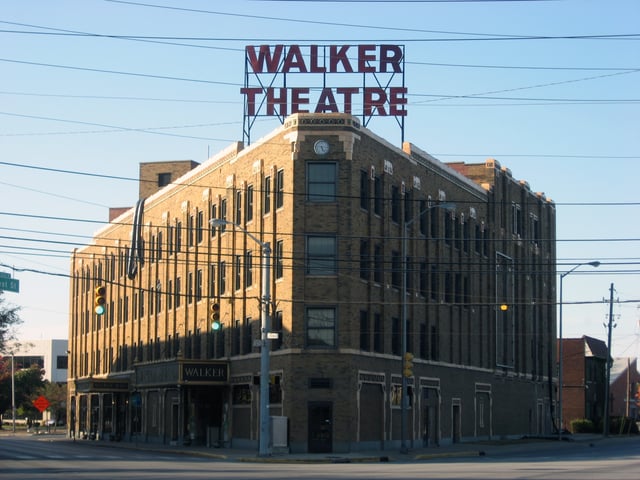
Madam Walker Legacy Center opened on Indiana Avenue in 1927 as a cultural center for the city's African American community.[198]
Indianapolis's most notable performing arts venues are in the Mass Ave cultural district or Downtown. The Indiana Theatre opened as a movie palace on Washington Street in 1927 and houses the Indiana Repertory Theatre, a regional repertory theatre. Located on Monument Circle since 1916, the 1,786-seat Hilbert Circle Theatre is the home of the Indianapolis Symphony Orchestra (ISO). Founded in 1930, the ISO performed 180 concerts to over 275,000 guests during the 2015–2016 season, generating a record $8.5 million in ticket sales.[197] The Indianapolis Opera, founded in 1975, maintains a collaborative relationship with the ISO.
In 1927, Madam Walker Legacy Center opened in the heart of the city's African-American neighborhood on Indiana Avenue.[199] The theater is named for Sarah Breedlove, or Madam C. J. Walker, an African American entrepreneur, philanthropist, and activist who began her beauty empire in Indianapolis. Indiana Avenue was home to a notable jazz scene from the 1920s through the 1960s, producing greats such as David Baker, Slide Hampton, Freddie Hubbard, J. J. Johnson, James Spaulding, and the Montgomery Brothers (Buddy, Monk, and Wes).[200] Wes Montgomery is considered one of the most influential jazz guitarists of all time,[200][201] and is credited with popularizing the "Naptown Sound."[202]
Mass Ave is home to the Old National Centre, Phoenix Theatre, and the Athenæum (Das Deutsche Haus). Old National Centre at the Murat Shrine is the oldest stage house in Indianapolis, opened in 1909.[203] The building is a prime example of Moorish Revival architecture and features a 2,600-seat performing arts theatre, 1,800-seat concert hall, and 600-seat multi-functional room, hosting approximately 300 public and private events throughout the year.[203] The nonprofit Phoenix Theatre focuses on contemporary theatrical productions.[204] The Athenӕum, houses the American Cabaret Theater and Young Actors Theater.
Other notable venues include the Indianapolis Artsgarden, a performing arts center suspended over the intersection of Washington and Illinois streets, Clowes Memorial Hall on the Butler University campus, Melody Inn in Butler-Tarkington, Rivoli Theater, and The Emerson Theater in Little Flower.
Indianapolis is home to Bands of America (BOA), a nationwide organization of high school marching, concert, and jazz bands, and the headquarters for Drum Corps International (DCI), a professional drum and bugle corps association.[205] Annual music events include the International Violin Competition of Indianapolis, Midwest Music Summit, and Indy Jazz Fest. The Heartland Film Festival, Indianapolis International Film Festival, Indianapolis Jewish Film Festival, Indianapolis Theatre Fringe Festival and the Indianapolis Alternative Media Festival are annual events held in the city.
Literature
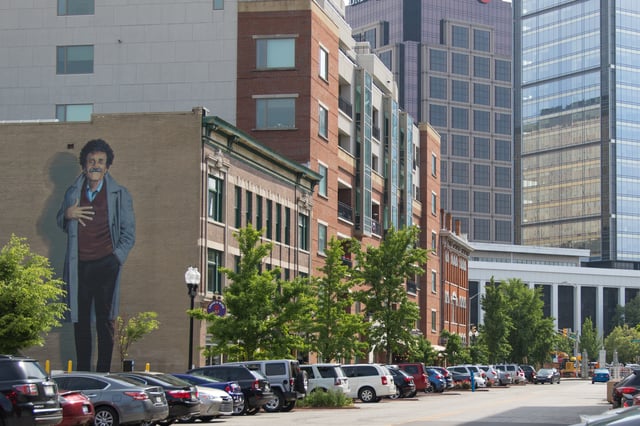
A mural memorializing Kurt Vonnegut stands on Mass Ave. The project was completed by local artist Pamela Bliss in 2011.
Indianapolis was at the center of the Golden Age of Indiana Literature from 1870 to 1920.[206] Several notable poets and writers based in the city achieved national prominence and critical acclaim during this period, including James Whitcomb Riley, Booth Tarkington and Meredith Nicholson.[23] In A History of Indiana Literature, Arthur W. Shumaker remarked on the era's influence: "It was the age of famous men and their famous books. In it Indiana, and particularly Indianapolis, became a literary center which in many ways rivaled the East."[207] A 1947 study found that Indiana authors ranked second to New York in the number of bestsellers produced in the previous 40 years.[206] Located in Lockerbie Square, the James Whitcomb Riley Museum Home has been a National Historic Landmark since 1962.
Perhaps the city's most famous 20th century writer was Kurt Vonnegut, known for his darkly satirical and controversial bestselling novel Slaughterhouse-Five (1969). The Kurt Vonnegut Memorial Library opened in 2010 downtown.[208] Vonnegut became known for including at least one character in his novels from Indianapolis.[209] Upon returning to the city in 1986, Vonnegut acknowledged the influence the city had on his writings:
Indianapolis is home to bestselling young adult fiction writer John Green, known for his critically acclaimed 2012 novel The Fault in Our Stars, set in the city.[210]
Attractions
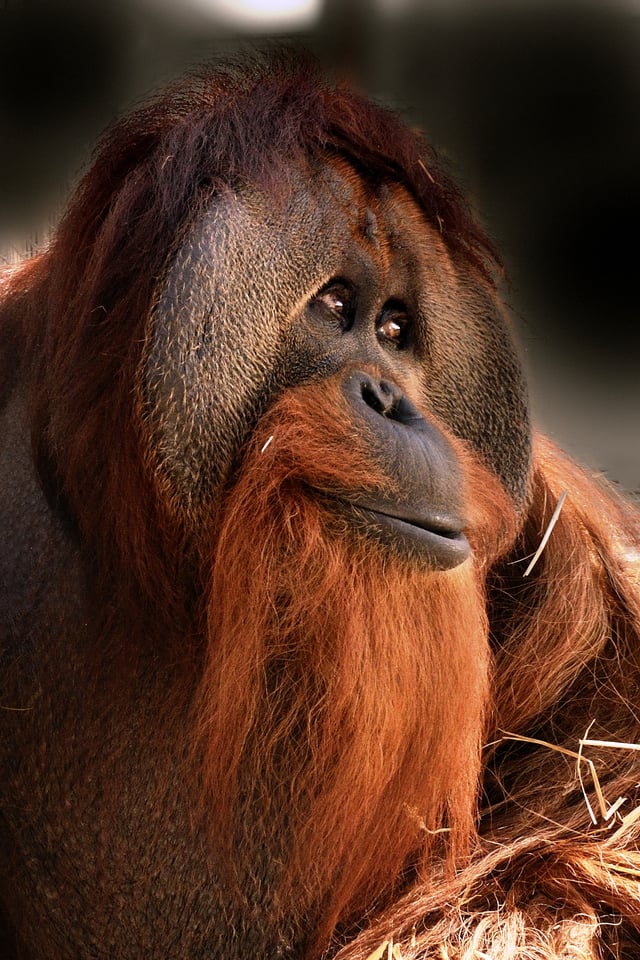
Azy, a male orangutan at the Indianapolis Zoo.
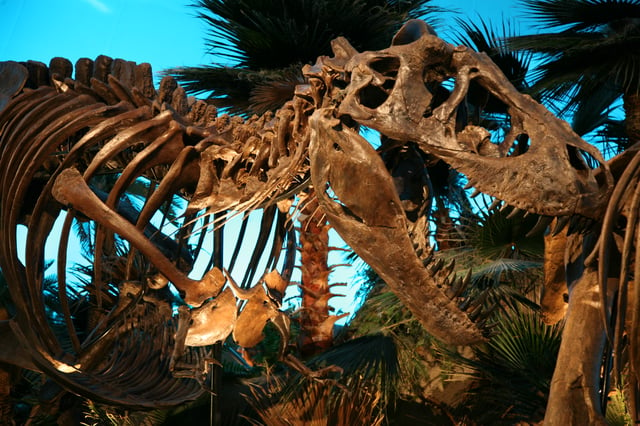
"Bucky," a juvenile Tyrannosaurus specimen at The Children's Museum of Indianapolis.
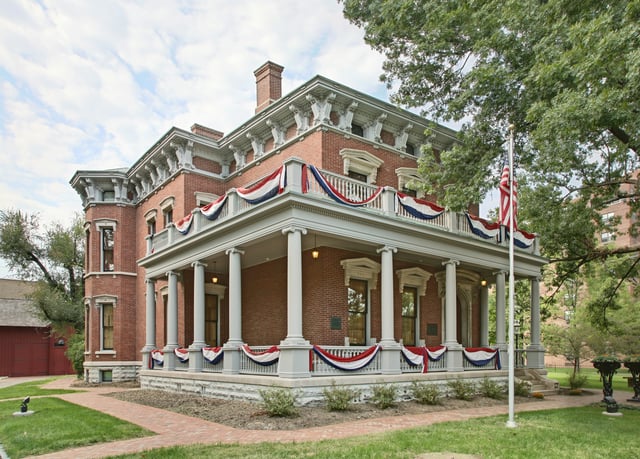
The Benjamin Harrison Presidential Site is a National Historic Landmark.
The Children's Museum of Indianapolis is the largest of its kind in the world, offering 433,000 square feet (40,227.02 m2) of exhibit space.[211] The museum holds a collection of over 120,000 artifacts, including the Broad Ripple Park Carousel, a National Historic Landmark.[212] Because of its leadership and innovations, the museum is a world leader in its field.[213] Child and Parents magazine have both ranked the museum as the best children's museum in the U.S.[214] The museum is one of the city's most popular attractions, with 1.2 million visitors in 2014.[215]
The Indianapolis Zoo is home to nearly 1,400 animals of 214 species and 31,000 plants, including many threatened and endangered species.[216][217] The zoo is a leader in animal conservation and research, recognized for its biennial Indianapolis Prize designation. It is the only American zoo accredited as a zoo, aquarium, and zoological garden by the Association of Zoos and Aquariums.[218] It is the largest privately funded zoo in the U.S. and one of the city's most visited attractions, with 1.2 million guests in 2014.[31][215]
The Indianapolis Motor Speedway Museum exhibits an extensive collection of auto racing memorabilia showcasing various motorsports and automotive history.[219][220] The museum is the permanent home of the Borg-Warner Trophy, presented to Indianapolis 500 winners.[28] Daily grounds and track tours are also based at the museum.[220] The NCAA Hall of Champions opened in 2000 at White River State Park housing collegiate athletic artifacts and interactive exhibits covering all 23 NCAA-sanctioned sports.[221][222]
Indianapolis is home to several centers commemorating Indiana history. These include the Indiana Historical Society, Indiana State Library and Historical Bureau, Indiana State Museum, and Indiana Medical History Museum. Indiana Landmarks, the largest private statewide historic preservation organization in the U.S., is also in the city.[223] The Benjamin Harrison Presidential Site, in the Old Northside Historic District, is open for daily tours and includes archives and memorabilia from the 23rd President of the United States. President Harrison is buried about 3 miles (4.8 km) north of the site at Crown Hill Cemetery, listed on the National Register of Historic Places. Other notable graves include three U.S. Vice Presidents and notorious American gangster, John Dillinger.
Two museums and several memorials in the city commemorate armed forces or conflict, including the Colonel Eli Lilly Civil War Museum at the Soldiers' and Sailors' Monument and Indiana World War Memorial Military Museum at the Indiana World War Memorial Plaza. Outside of Washington, D.C., Indianapolis contains the largest collection of monuments dedicated to veterans and war casualties in the nation.[33][34] Other notable sites are the Confederate Soldiers and Sailors Monument, Crown Hill National Cemetery, the Medal of Honor Memorial, Project 9/11 Indianapolis, and the USS Indianapolis National Memorial.
Cuisine
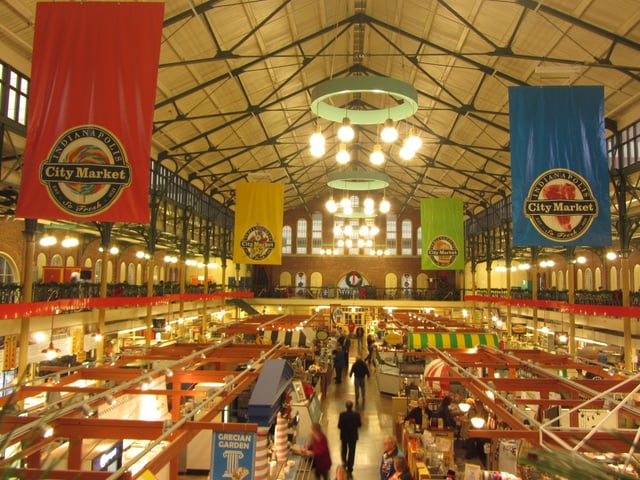
Indianapolis City Market was founded in 1821.
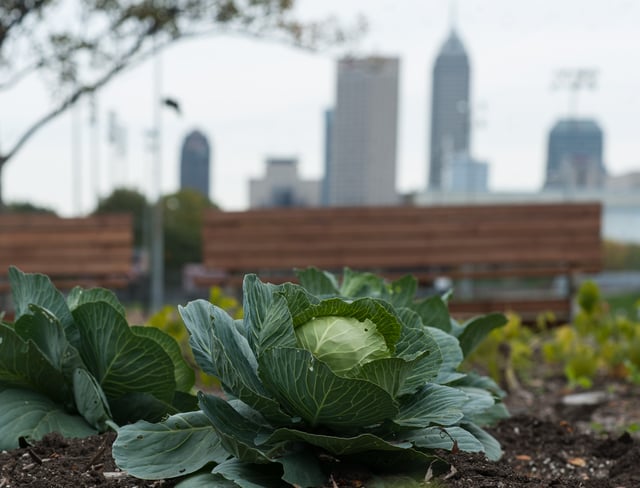
Urban agriculture on the campus of IUPUI.
Indianapolis has an emerging food scene as well as established eateries.[224] Founded in 1821 as the city's public market, the Indianapolis City Market has served the community from its current building since 1886. Prior to World War II, the City Market and neighboring Tomlinson Hall (since demolished) were home to meat and vegetable vendors. As consumer habits evolved and residents moved from the central city, the City Market transitioned from a traditional marketplace to a food court, a function it retains today.[225]
Opened in 1902, St. Elmo Steak House is well known for its signature shrimp cocktail, named by the Travel Channel as the "world's spiciest food". In 2012, it was recognized by the James Beard Foundation as one of "America's Classics".[226] The Slippery Noodle Inn, a blues bar and restaurant, is the oldest continuously operating tavern in Indiana, having opened in 1850.[227] The Jazz Kitchen, opened in 1994, was recognized in 2011 by OpenTable as one the "top 50 late night dining hotspots" in the U.S.[228]
In 2016, Condé Nast Traveler named Indianapolis the "most underrated food city in the U.S.," while ranking Milktooth as one of the best restaurants in the world.[232][233] Food & Wine called Indianapolis the "rising star of the Midwest," recognizing Milktooth, Rook, Amelia's, and Bluebeard, all in Fletcher Place.[234][235] Several Indianapolis chefs and restaurateurs have been semifinalists in the James Beard Foundation Awards in recent years.[236][237] Microbreweries are quickly becoming a staple in the city, increasing fivefold since 2009.[238] There are now about 50 craft brewers in Indianapolis, with Sun King Brewing being the largest.[239]
For some time, Indianapolis was known as the "100 Percent American City" for its racial and ethnic homogeneity.[240] Historically, these factors, as well as low taxes and wages, provided chain restaurants a relatively stable market to test dining preferences before expanding nationwide. As a result, the Indianapolis metropolitan area had the highest concentration of chain restaurants per capita of any market in the U.S. in 2008, with one chain restaurant for every 1,459 people—44% higher than the national average.[241] In recent years, immigrants have opened some 800 ethnic restaurants.[240]
Urban agriculture has become increasingly prevalent throughout the city in an effort to alleviate food deserts. In 2018, the Indy Food Council reported a 272% increase in the number of community and urban gardens between 2011 and 2016.[242]
Sports
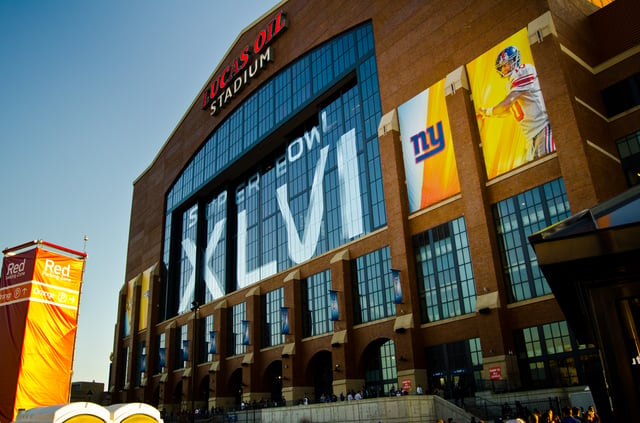
Lucas Oil Stadium during Super Bowl XLVI. The stadium is home to the Indianapolis Colts and Indy Eleven.

Bankers Life Fieldhouse, home to the Indiana Pacers and Indiana Fever since 1999.

Victory Field, home to the Indianapolis Indians since 1996.
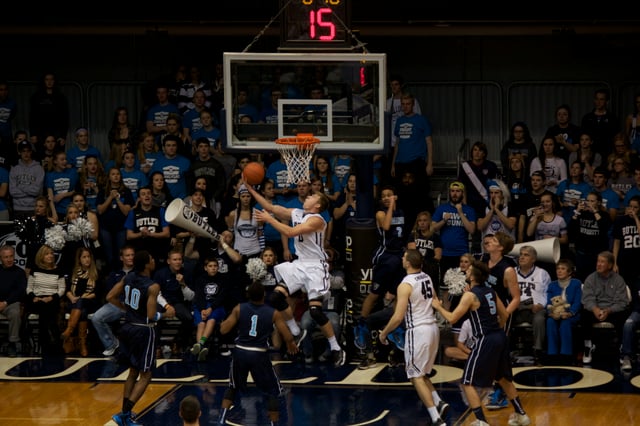
A Butler Bulldogs men's basketball game at Hinkle Fieldhouse.
Two major league sports teams are based in Indianapolis: the Indianapolis Colts of the National Football League (NFL) and the Indiana Pacers of the National Basketball Association (NBA).
Originally the Baltimore Colts, the franchise has been based in Indianapolis since relocating in 1984. The Colts' tenure in Indianapolis has produced 11 division championships, two conference championships, and two Super Bowl appearances. Quarterback Peyton Manning led the team to win Super Bowl XLI in the 2006 NFL season. Lucas Oil Stadium replaced the team's first home, the RCA Dome, in 2008.
Founded in 1967, the Indiana Pacers began in the American Basketball Association (ABA), joining the NBA when the leagues merged in 1976. Prior to joining the NBA, the Pacers won three division titles and three championships (1970, 1972, 1973). Since the merger, the Pacers have won one conference title and six division titles, most recently in 2014.
Founded in 2000, the Indiana Fever of the Women's National Basketball Association (WNBA) have won three conference titles and one championship in 2012. The Fever and Pacers share Bankers Life Fieldhouse, which replaced Market Square Arena in 1999. The Indianapolis Indians of the International League (AAA) is the second oldest minor league franchise in American professional baseball, established in 1902.[243] The Indians have won 25 division titles, 14 league titles, and seven championships, most recently in 2000. Since 1996, the team has played at Victory Field, which replaced Bush Stadium. Of the 160 teams comprising Minor League Baseball, the Indians had the highest attendance during the 2016 season.[244] Established in 2013, Indy Eleven of the United Soccer League (USL) plays from Lucas Oil Stadium. Indy Fuel of the ECHL was founded in 2014 and plays from Indiana Farmers Coliseum.
Butler University and Indiana University – Purdue University Indianapolis (IUPUI) are NCAA Division I schools based in the city. The Butler Bulldogs compete in the Big East Conference, except for Butler Bulldogs football, which plays in the Pioneer Football League FCS. The Butler Bulldogs men's basketball team were runners-up in the 2010 and 2011 NCAA Men's Division I Basketball Championship Games. The IUPUI Jaguars compete in the Summit League.
Traditionally, Indianapolis's Hinkle Fieldhouse was the hub for Hoosier Hysteria, a general excitement for the game of basketball throughout the state, specifically the Indiana High School Boys Basketball Tournament.[245] Hinkle, a National Historic Landmark, was opened in 1928 as the world's largest basketball arena, with seating for 15,000.[246] It is regarded as "Indiana's Basketball Cathedral". Perhaps the most notable game was the 1954 state championship, which inspired the critically acclaimed 1986 film, Hoosiers.[247]
Indianapolis has been called the "Amateur Sports Capital of the World".[48][248] The National Collegiate Athletic Association (NCAA), the main governing body for U.S. collegiate sports, and the National Federation of State High School Associations are based in Indianapolis. The city is home to three NCAA athletic conferences: the Horizon League (Division I); the Great Lakes Valley Conference (Division II); and the Heartland Collegiate Athletic Conference (Division III). Indianapolis is also home to three national sport governing bodies, as recognized by the United States Olympic Committee: USA Gymnastics; USA Diving; and USA Track & Field.[249]
Indianapolis hosts numerous sporting events annually, including the Circle City Classic (1983–present), NFL Scouting Combine (1987–present), and Big Ten Football Championship Game (2011–present). Indianapolis is tied with New York City for having hosted the second most NCAA Men's Division I Basketball Championships (1980, 1991, 1997, 2000, 2006, 2010, and 2015).[250] The city will host the men's Final Four next in 2021.[251] The city has also hosted three NCAA Women's Division I Basketball Championships (2005, 2011, and 2016). Notable past events include the NBA All-Star Game (1985), Pan American Games X (1987), US Open Series Indianapolis Tennis Championships (1988–2009), WrestleMania VIII (1992), World Rowing Championships (1994), World Police and Fire Games (2001), FIBA Basketball World Cup (2002), and Super Bowl XLVI (2012).
Indianapolis is home to the OneAmerica 500 Festival Mini-Marathon, the largest half marathon and seventh largest running event in the U.S.[252] The mini-marathon is held the first weekend of May as part of the 500 Festival, leading up to the Indianapolis 500. As of 2013, it had sold out for 12 consecutive years, with 35,000 participants.[253] Held in autumn, the Monumental Marathon is also among the largest in the U.S., with nearly 14,000 entrants in 2015.[254]
Motorsports
Indianapolis is a major center for motorsports. Two auto racing sanctioning bodies are headquartered in the city (INDYCAR and United States Auto Club) along with more than 500 motorsports companies and racing teams, employing some 10,000 people in the region.[255] Indianapolis is so well connected with auto racing that it has inspired the name "Indy car," used for both the competition and type of car used in it.[256]
Since 1911, Indianapolis Motor Speedway (IMS) (in the enclave of Speedway, Indiana) has been the site of the Indianapolis 500, an open-wheel automobile race held annually on Memorial Day weekend. Considered part of the Triple Crown of Motorsport, the Indianapolis 500 is the world's largest single-day sporting event, hosting more than 257,000 permanent seats.[28] Since 1994, IMS has hosted one of NASCAR's highest attended events, the Monster Energy Cup Series Brickyard 400.[257] IMS has also hosted the NASCAR Xfinity Series Lilly Diabetes 250 since 2012 and the IndyCar Series Grand Prix of Indianapolis since 2014.
Lucas Oil Raceway, in nearby Brownsburg, is home to the National Hot Rod Association (NHRA) U.S. Nationals, the most prestigious drag racing event in the world, held annually each Labor Day weekend.[258]
Parks and recreation
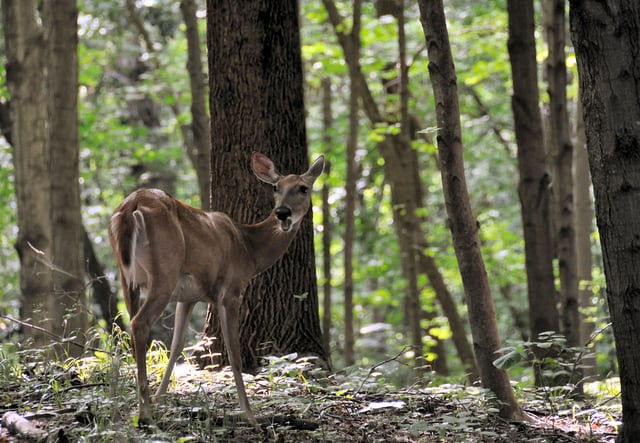
A white-tailed deer in Eagle Creek Park, one of the largest municipal parks in the U.S.
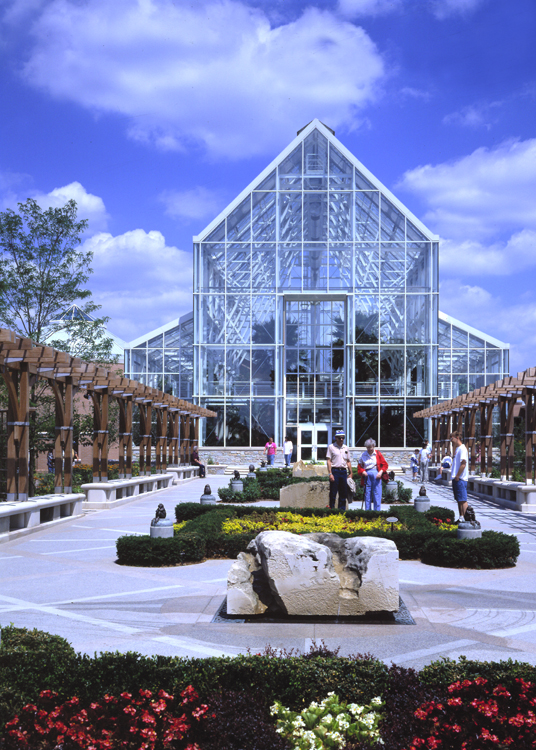
Hilbert Conservatory at White River Gardens in White River State Park.
Indy Parks and Recreation maintains 211 parks covering 11,254 acres (4,554 ha).[259] Eagle Creek Park is the largest and most visited park in the city and ranks among the largest municipal parks in the U.S., covering 4,766 acres (1,929 ha).[260] Fishing, sailing, kayaking, canoeing, and swimming are popular activities at Eagle Creek Reservoir. Notable recreational shared use paths include the Downtown Canal Walk, Pleasant Run Trail, and Monon Trail. The Monon is a popular rail trail and part of the United States Bicycle Route System, drawing some 1.3 million people annually.[261][262] There are 13 public golf courses in the city.[263]
Military Park was established as the city's first public park in 1852.[264] By the 20th century, the city enlisted landscape architect George Kessler to conceive a framework for Indianapolis's modern parks system.[265] Kessler's 1909 Indianapolis Park and Boulevard Plan linked notable parks, such as Brookside, Ellenberger, and Garfield, with a system of parkways following the city's waterways.[266] In 2003, the system's 3,474 acres (1,406 ha) were added to the National Register of Historic Places.[267]
Marion County is home to two of Indiana's 25 state parks: Fort Harrison in Lawrence and White River downtown. Fort Harrison is managed by the Indiana Department of Natural Resources. White River is owned and operated by the White River State Park Development Commission, a quasi-governmental agency.[268] Encompassing 250 acres (100 ha), White River is the city's major urban park, home to the Indianapolis Zoo and White River Gardens.[216] Indianapolis lies about 50 miles (80 km) north of two state forests, Morgan–Monroe and Yellowwood, and one national forest, Hoosier. Crown Hill Cemetery, the third largest private cemetery in the U.S., covers 555 acres (225 ha) on the city's north side and is home to more than 250 species of trees and shrubs comprising one of the largest old-growth forests in the Midwest.[269][270]
According to the Trust for Public Land's 2017 ParkScore Index, Indianapolis tied for last with respect to public park accessibility of the 100 largest U.S. cities evaluated. Some 68% of residents are underserved. The city's large land area and low public funding contributed to the ranking.[271]
Government and politics
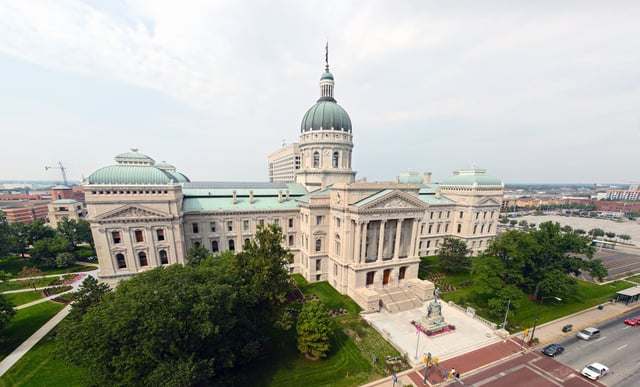
The Indiana Statehouse houses the executive, legislative, and judicial branches of state government.

The Birch Bayh Federal Building and United States Courthouse is home to the U.S. District Court for the Southern District of Indiana.
Indianapolis has a consolidated city-county government, a status it has held since 1970 under Indiana Code's Unigov provision. Many functions of the city and county governments are consolidated, though some remain separate.[7] The city has a strong mayor–council form of government.
The executive branch is headed by an elected mayor, who serves as the chief executive of both the city and Marion County. Joe Hogsett, a Democrat, is the 49th mayor of Indianapolis. The mayor appoints deputy mayors, department heads, and members of various boards and commissions. City-County Council is the legislative body and consists of 25 members, all of whom represent geographic districts. The council has the exclusive power to adopt budgets, levy taxes, and make appropriations. It can also enact, repeal, or amend ordinances, and make appointments to certain boards and commissions. According to Moody's, the city maintains a Aaa bond credit rating, with an annual budget of $1.1 billion.[272][273] The judicial branch consists of a circuit court, a superior court with four divisions and 32 judges, and a small claims court.[7] The three branches, along with most local government departments, are based in the City-County Building.
As the state capital, Indianapolis is the seat of Indiana's state government. The city has hosted the capital since its move from Corydon in 1825. The Indiana Statehouse, located downtown, houses the executive, legislative, and judicial branches of state government, including the offices of the Governor of Indiana and Lieutenant Governor of Indiana, the Indiana General Assembly, and the Indiana Supreme Court. Most state departments and agencies are in Indiana Government Centers North and South. The Indiana Governor's Residence is on Meridian Street in the Butler–Tarkington neighborhood, about 5 miles (8.0 km) north of downtown.
Most of Indianapolis is within Indiana's 7th congressional district, represented by André Carson (D–Indianapolis), while the northern fifth is part of Indiana's 5th congressional district, represented by Susan Brooks (R–Carmel).[274] Federal field offices are in the Birch Bayh Federal Building and United States Courthouse (which houses the United States District Court for the Southern District of Indiana) and the Minton-Capehart Federal Building, both downtown. The Defense Finance and Accounting Service, an agency of the U.S. Department of Defense, is headquartered in nearby Lawrence.
Public safety
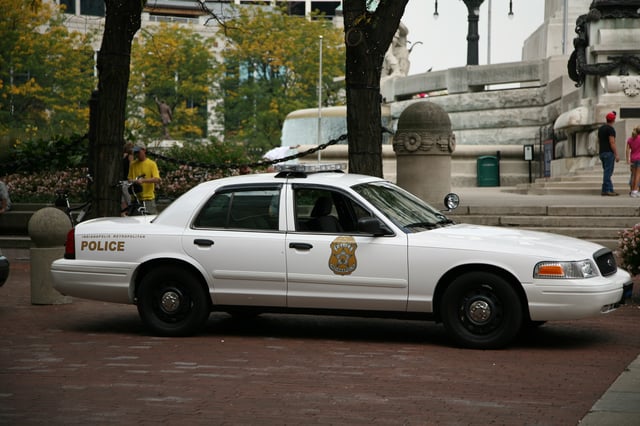
Indianapolis Metropolitan Police Department interceptor in 2008.
Indianapolis Emergency Medical Services is the largest provider of pre-hospital medical care in the city, responding to 95,000 emergency dispatch calls annually.[275] The agency's coverage area includes six townships within the city (Center, Franklin, Lawrence, Perry, Warren, and Washington) and the town of Speedway. As of 2018, Charles Miramonti, MD was the EMS chief.[276]
The Indianapolis Fire Department (IFD) provides fire protection services as the primary emergency response agency for 278 square miles (720 km2) of Marion County. IFD provides automatic and mutual aid to the excluded municipalities of Beech Grove, Lawrence, and Speedway, as well as Decatur, Pike, and Wayne townships who have retained their own fire departments. The fire district comprises seven geographic battalions with 44 fire stations, dual-staffing a forty-fifth station with the City of Lawrence Fire Department.[7] As of 2014, 1,205 sworn firefighters responded to nearly 100,000 incidents annually.[277] As of 2018, Ernest Malone was the fire chief.[278]
Indianapolis Metropolitan Police Department (IMPD) is the primary law enforcement agency for the city of Indianapolis. IMPD's jurisdiction covers Marion County, with the exceptions of Beech Grove, Lawrence, Southport, Speedway, and the Indianapolis International Airport, which is served by the Indianapolis Airport Authority Police Department.[279] IMPD was established in 2007 through a merger between the Indianapolis Police Department and the Marion County Sheriff's Office Law Enforcement Division.[280] The Marion County Sheriff's Office maintains and operates Marion County Jails I and II. In 2016, IMPD operated six precincts with 1,640 sworn police personnel and 200 civilian employees.[7] As of 2018, Bryan Roach was the chief of police.[281]
Crime
According to the FBI's 2015 Uniform Crime Report, Indianapolis ranks as the 16th most dangerous city in the U.S., with 17.1 homicides per 100,000 people, compared with the U.S. rate of 4.9 homicides per 100,000 people.[282] Between 2012 and 2014, the murder rate rose by 44%. There were 138 homicides in 2014, with 60% of victims and 90% of perpetrators being young black men.[283] With 144 criminal homicides, 2015 surpassed 1998 as the year with the most murder investigations in the city. With 154 criminal homicides, 2017 marked the third consecutive year of record violence. FBI data showed a 7 percent increase in violent crimes committed in Indianapolis, outpacing the rest of the state and country.[284] Law enforcement has blamed increased violence on a combination of root causes, including poverty, substance abuse, mental illness, and availability of firearms.[285]
Politics
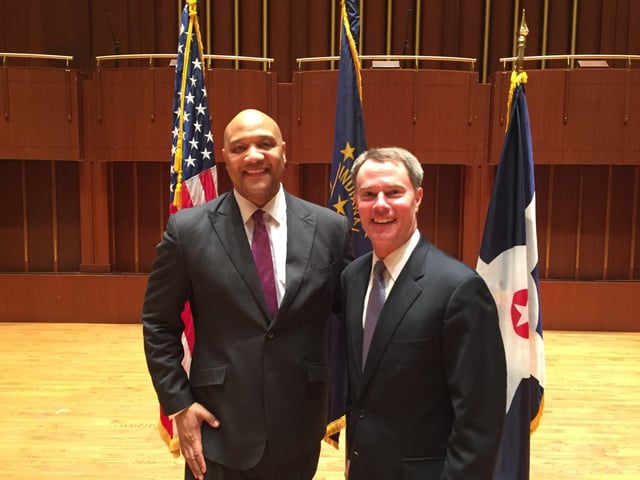
U.S. Representative for Indiana's 7th congressional district, André Carson (left) with Indianapolis Mayor Joe Hogsett in 2016.
| Year | Republican | Democratic | Others |
|---|---|---|---|
| 2016 | 35.5% 130,360 | 58.0% 212,899 | 6.4% 23,620 |
| 2012 | 37.9% 136,509 | 60.1% 216,336 | 2.0% 7,127 |
| 2008 | 35.3% 134,313 | 63.7% 241,987 | 1.0% 3,790 |
| 2004 | 48.7% 156,072 | 50.6% 162,249 | 0.8% 2,517 |
| 2000 | 49.2% 137,810 | 47.9% 134,189 | 2.8% 7,904 |
| 1996 | 47.2% 133,329 | 44.1% 124,448 | 8.7% 24,437 |
| 1992 | 43.7% 141,369 | 37.8% 122,234 | 18.6% 60,187 |
| 1988 | 58.6% 184,519 | 40.8% 128,627 | 0.6% 1,949 |
Until fairly recently, Indianapolis was considered one of the most conservative major cities in the U.S.[74] Republicans held the mayor's office for 32 years (1967–1999), and controlled the City-County Council from its inception in 1970 to 2003.[74] Since the early-2000s, the city's politics have gradually shifted more toward the Democrats. As of 2014, the city is regarded as politically moderate.[287]
Republican Greg Ballard chose not to run for a third term in the 2015 mayoral election.[288] Republican Chuck Brewer and Democrat Joe Hogsett were the candidates to replace him. Each had similar plans for addressing the city's issues, and the commonality between them contributed to a very low voter turnout.[289] Hogsett previously held public office as Indiana Secretary of State and as U.S. Attorney for the Southern District of Indiana, and had served in government for over 30 years, giving him greater name recognition than Brewer, a local restaurateur.[290] Hogsett was elected with 63% of the vote, officially taking office on January 1, 2016.[290]
The 2015 City-County Council elections also left Democrats in control of the council, holding a 13–12 majority over Republicans, only the second time since the creation of Unigov that Democrats controlled both the mayor's office and council.[291]
Education
Colleges and universities
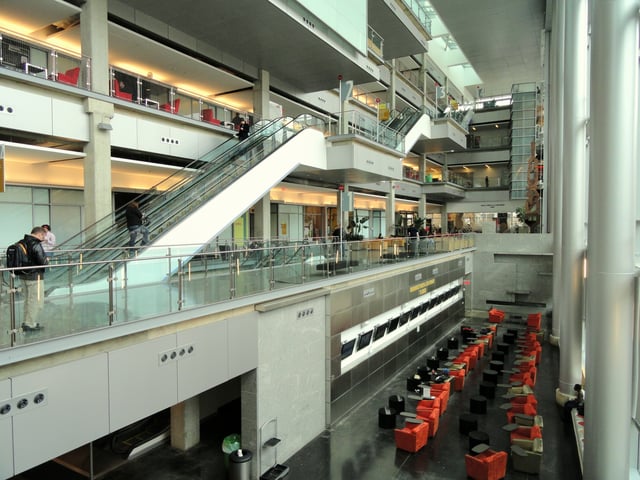
Indiana University – Purdue University Indianapolis has the city's largest higher education enrollment.
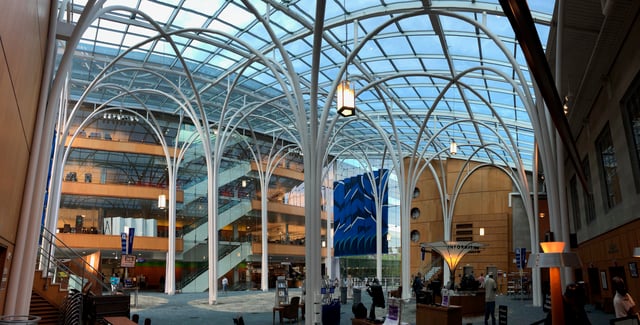
The Indianapolis Public Library's Central Library is the hub of its 23-branch system.
Indiana University – Purdue University Indianapolis (IUPUI) was founded in 1969 after merging the branch campuses of Indiana University and Purdue University.[293] IUPUI's enrollment is 29,800, the third-largest in the state.[293] IUPUI has two colleges and 18 schools, including the Herron School of Art and Design, Robert H. McKinney School of Law, School of Dentistry, and the Indiana University School of Medicine, the largest medical school in the U.S.[294][295] The city is home to the largest campus for Ivy Tech Community College of Indiana, a state-funded community college serving 77,600 students statewide.[296]
Five private universities are based in Indianapolis. Established in 1855, Butler University is the oldest higher education institution in the city, with a total enrollment of about 5,000.[297] Affiliated with the Roman Catholic Church, Marian University was founded in 1936 when St. Francis Normal and Immaculate Conception Junior College merged, moving to Indianapolis in 1937. Marian has an enrollment of about 3,100 students.[298] Founded in 1902, the University of Indianapolis is affiliated with the United Methodist Church. The school's enrollment is 5,700 students.[299] Martin University was founded in 1977 and is the state's only predominately black university.[300] Crossroads Bible College and Indiana Bible College are small Christian colleges in the city.
Satellite campuses in the city include Ball State University's R. Wayne Estopinal College of Architecture and Planning, Grace College, Indiana Institute of Technology, Indiana Wesleyan University, and Vincennes University.
Schools and libraries
Nine public school districts serve residents of Indianapolis: Franklin Township Community School Corporation, MSD Decatur Township, MSD Lawrence Township, MSD Perry Township, MSD Pike Township, MSD Warren Township, MSD Washington Township, MSD Wayne Township, and Indianapolis Public Schools (IPS). As of 2016, IPS was the second largest public school district in Indiana, serving nearly 30,000 students.[7][301]
A number of private primary and secondary schools are operated through the Archdiocese of Indianapolis, charters, or other independent organizations. Founded in 1873, the Indianapolis Public Library includes the Central Library and 23 branches throughout Marion County. The Indianapolis Public Library served 4.2 million patrons in 2014, with a circulation of 15.9 million materials.[302]
Media

The Indianapolis Star is the city's daily morning newspaper and leading print media.
Indianapolis is served by various print media. Founded in 1903, The Indianapolis Star is the city's daily morning newspaper. The Star is owned by Gannett Company, with a daily circulation of 127,064.[303] The Indianapolis News was the city's daily evening newspaper and oldest print media, published from 1869 to 1999. Notable weeklies include NUVO, an alternative weekly newspaper, the Indianapolis Recorder, a weekly newspaper serving the local African American community, the Indianapolis Business Journal, reporting on local real estate, and the Southside Times. Indianapolis Monthly is the city's monthly lifestyle publication.
Broadcast television network affiliates include WTTV 4 (CBS), WRTV 6 (ABC), WISH-TV 8 (The CW), WTHR-TV 13 (NBC), WDNI-CD 19 (Telemundo), WFYI-TV 20 (PBS), WNDY-TV 23 (MyNetworkTV), WUDZ-LD 28 (Buzzr), WSDI-LD 30 (Quest), WHMB-TV 40 (Family), WCLJ-TV 42 (Ion Life), WBXI-CD 47 (Decades), WXIN-TV 59 (Fox), WIPX-TV 63 (Ion) and WDTI 69 (Daystar). The majority of commercial radio stations in the city are owned by Cumulus Media, Emmis Communications, iHeartMedia, and Urban One. Popular nationally syndicated radio program The Bob & Tom Show has been based at Indianapolis radio station WFBQ since 1983.[304] As of 2016, the Indianapolis metropolitan area was the 27th largest television market and 39th largest radio market in the U.S.[305][306]
Indianapolis natives Jane Pauley and David Letterman launched their notable broadcasting careers in local media, Pauley with WISH-TV and Letterman with WTHR-TV, respectively.[307][308] Motion pictures at least partially filmed in the city include Speedway,[309] To Please a Lady,[310] Winning,[311] Hoosiers,[312] Going All the Way,[313] and Eight Men Out.[314] Television series set in Indianapolis have included One Day at a Time; Good Morning, Miss Bliss; Men Behaving Badly; Cops;[315] Close to Home;[316] the second season of anthology drama American Crime,[317] and HGTV's Good Bones.[318]
Transportation
Indianapolis's transportation infrastructure comprises a complex network that includes a local public bus network, several private intercity bus providers, Amtrak passenger rail service via the Cardinal, multiple freight train lines, an Interstate Highway System, two airports, a heliport, carshare and bikeshare systems, and miles of bike lanes and trails. The city has also become known for its prevalence of electric scooters.[319]
According to the 2016 American Community Survey, 83.7% of working city of Indianapolis residents commuted by driving alone, 8.4% carpooled, 1.5% used public transportation, and 1.8% walked. About 1.5% used all other forms of transportation, including taxicab, motorcycle, and bicycle. About 3.1% of working city of Indianapolis residents worked at home.[320] In 2015, 10.5 percent of Indianapolis households lacked a car, which decreased to 8.7 percent in 2016. The national average was 8.7 percent in 2016. Indianapolis averaged 1.63 cars per household in 2016, compared to a national average of 1.8.[321]
Airports
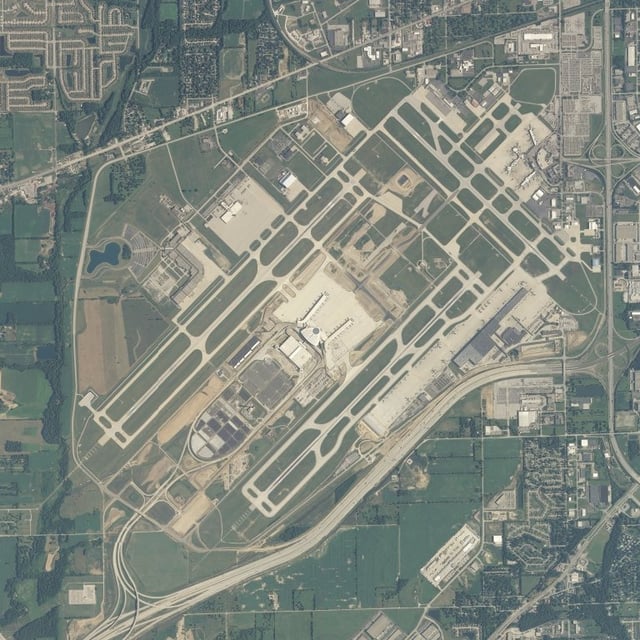
Satellite image of Indianapolis International Airport.
Indianapolis International Airport (IND) sits on 7,700 acres (3,116 ha) approximately 7 miles (11 km) southwest of downtown Indianapolis. IND is the busiest airport in the state, serving more than 9.4 million passengers annually.[322] Completed in 2008, the Col. H. Weir Cook Terminal contains two concourses and 40 gates, connecting to 51 nonstop domestic and international destinations and averaging 145 daily departures.[323] As home to the second largest FedEx Express hub in the world, IND ranked as the seventh busiest U.S. airport in terms of air cargo throughput in 2015.[164][324]
The Indianapolis Airport Authority is a municipal corporation that oversees operations at five additional airports in the region, two of which are in Indianapolis: Eagle Creek Airpark (EYE), a relief airport for IND, and the Indianapolis Downtown Heliport (8A4).[325]
Roads and highways
Four Interstates intersect the city: Interstate 65, Interstate 69, Interstate 70, and Interstate 74. Two auxiliary Interstate Highways are in the metropolitan area: a beltway (Interstate 465) and connector (Interstate 865). A $3 billion expansion project to extend Interstate 69 from Evansville to Indianapolis is in progress.[326] The Indiana Department of Transportation manages all Interstates, U.S. Highways, and Indiana State Roads within the city.
The city's Department of Public Works manages about 8,100 miles of street lanes, in addition to alleys, bridges, sidewalks, and curbs.[327]
Public transit
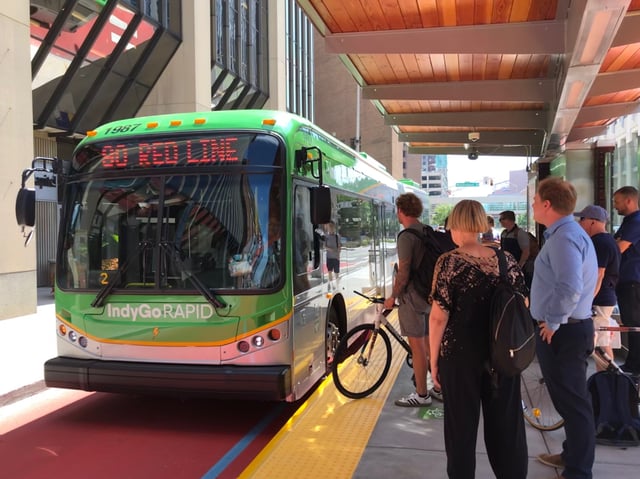
IndyGo Rapid bus at the Red Line Statehouse Station.
The Indianapolis Public Transportation Corporation, branded as IndyGo, operates the city's public bus system. In 2016, the Julia M. Carson Transit Center opened, the downtown hub for 27 of its 31 bus routes.[328] In 2017, City-County Council approved a voter referendum increasing Marion County's income tax to help fund IndyGo's first major system expansion since its founding in 1975. The Marion County Transit Plan outlines proposed system improvements, including three bus rapid transit (BRT) lines, new buses, sidewalks, and bus shelters, extended hours and weekend schedules, and a 70% increase in service hours on all existing local routes.[329][330][331] Phase I of IndyGo's Red Line, the first of the three planned BRT lines, began service on September 1, 2019.[332] The $96.3 million project includes a $75 million grant from the Federal Transit Administration.[333]
The Central Indiana Regional Transportation Authority (CIRTA) is a quasi-governmental agency that organizes regional car and vanpools and operates three public workforce connectors from Indianapolis to employment centers in Plainfield and Whitestown.
Active and shared mobility

Bolloré Bluecar's BlueIndy at a charging station in Broad Ripple.
Reliance on the automobile has affected the city's development patterns, with Walk Score ranking Indianapolis as one of the least walkable large cities in the U.S.[334] The city has enhanced bicycle and pedestrian infrastructure in recent years, with some 75 miles (121 km) of trails and 90 miles (140 km) of on-street bike lanes.[335]
The Indianapolis Cultural Trail and BCycle launched Indiana Pacers Bikeshare in April 2014 as the city's bicycle-sharing system, consisting of 525 bicycles at 50 stations.[336] Indianapolis is home to Bolloré Bluecar's BlueIndy, the first electric carsharing service in the U.S., which launched in September 2015.[337] BlueIndy provides 200 electric cars and 92 charging stations throughout the city.[338] Transportation network companies Lyft and Uber are available by mobile app in the city, as well as traditional taxicabs.[339] After negotiations with city officials, Bird and Lime electric scooter-sharing launched in September 2018.[340]
Intercity transit
Amtrak provides intercity rail service to Indianapolis via Union Station, serving about 30,000 passengers in 2015.[168] The Cardinal makes three weekly trips between New York City and Chicago. Several private intercity bus service providers stop in the city. Greyhound Lines operates a bus terminal at Union Station and stop at Indianapolis International Airport's Ground Transportation Center.[341] Barons Bus Lines, Burlington Trailways, and Miller Transportation's Hoosier Ride also stop at Greyhound's Union Station bus terminal.[342] Megabus stops at the corner of North Alabama Street and East Market Street near the Indianapolis City Market.[343] GO Express Travel manages two shuttle services: GO Green Express between downtown Indianapolis and the Indianapolis International Airport and Campus Commute between IUPUI and Indiana University Bloomington.[344][345] OurBus began daily service between Indianapolis and Chicago, with stops in Zionsville and Lafayette, filling a gap left after Amtrak's Hoosier State was discontinued in July 2019.[346]
Healthcare
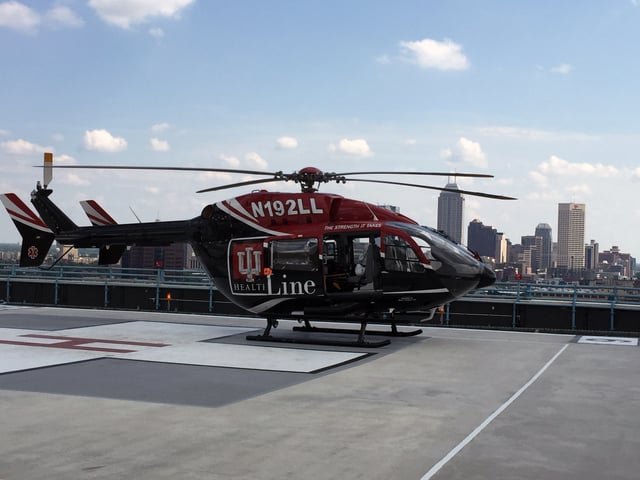
LifeLine at Indiana University Health Methodist Hospital, the largest medical center in Indiana, with 589 beds.[347]
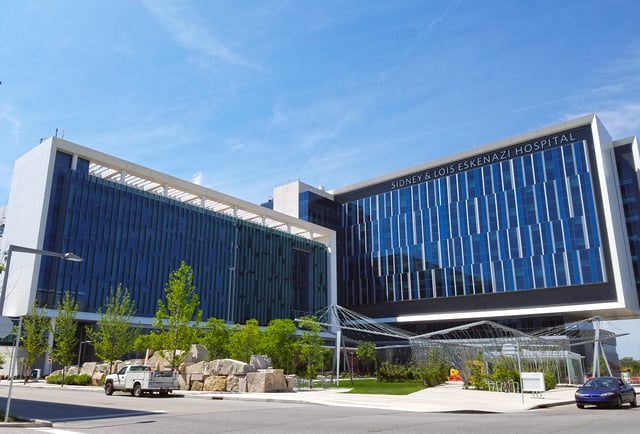
Sidney & Lois Eskenazi Hospital is the flagship medical center for Indiana's oldest healthcare system, founded in 1859 as Indianapolis City Hospital.
Indiana University Health's Academic Health Center encompasses Marion County, with the medical centers of University Hospital, Methodist Hospital, and Riley Hospital for Children. The Academic Health Center is anchored by the Indiana University School of Medicine's principal research and education campus, the largest allopathic medical school in the U.S.[294][295] Riley Hospital for Children is among the nation's foremost pediatric health centers, recognized in all ten specialties by U.S. News and World Report, including top 25 honors in orthopedics (23), nephrology (22), gastroenterology and GI surgery (16), pulmonology (13), and urology (4).[348] The 430-bed facility also contains Indiana's only Pediatric Level I Trauma Center.[349]
Health & Hospital Corporation of Marion County, a municipal corporation, was formed in 1951 to manage the city's public health facilities and programs, including the Marion County Public Health Department and Eskenazi Health.[350] Eskenazi Health's flagship medical center, the Sidney & Lois Eskenazi Hospital, opened in 2013 after a $754 million project to replace Wishard Memorial Hospital.[351] The hospital includes an Adult Level I Trauma Center, 315 beds, and 275 exam rooms, annually serving about 1 million outpatients.[352] Opened in 1932, the Richard L. Roudebush VA Medical Center is Indiana's tertiary referral hospital for former armed services personnel, treating more than 60,000 veterans annually.[353]
Located on the city's far north side, St. Vincent Indianapolis Hospital is the flagship medical center of St. Vincent Health's 22-hospital system. St. Vincent Indianapolis includes Peyton Manning Children's Hospital, St. Vincent Heart Center of Indiana, St. Vincent Seton Specialty Hospital, and St. Vincent Women's Hospital. Franciscan Health Indianapolis's flagship medical center is on the city's far south side.
Community Health Network contains dozens of specialty hospitals and three emergency medical centers in Marion County, including Community Hospital South, Community Hospital North, and Community Hospital East. Community Hospital East replaced its 60-year-old facility with a $175 million, 150-bed hospital in 2019.[354] The campus also includes a $120 million, 159-bed state-funded psychiatric and chronic addiction treatment facility. The Indiana NeuroDiagnostic Institute and Advanced Treatment Center will replace the antiquated Larue D. Carter Memorial Hospital in 2019.[355]
According to Indianapolis-based American College of Sports Medicine's 2016 American Fitness Index Data Report, the city scored last of the 50 largest U.S. metropolitan areas for health and community fitness.[356] Higher instances of obesity, coronary heart disease, diabetes, smoking, and asthma contributed to the ranking.[357] After the annual listing expanded to the 100 largest U.S. cities in 2019, Indianapolis ranked 96th.[358]
Utilities

Perry K. Generating Station produces steam for the city's district heating system.
Electricity is provided by Indianapolis Power & Light (IPL), a subsidiary of AES Corporation.[359] Despite a portfolio comprised 100% of nonrenewable energy sources in 2007, IPL ended coal-firing operations at its Harding Street Station in 2016.[360] Today, IPL generates 3,343 MW of electricity at four power stations, two wind farms,[360] and 34 solar farms,[361] covering a service area of 528 square miles (1,370 km2).[362] In 2017, Indianapolis had the fourth highest number of photovoltaics per capita in the U.S.[361]
Citizens Energy Group provides residents with natural gas, water, wastewater, and thermal services.[363][364] Citizens is the only public charitable trust formed to operate utilities in the U.S.[365] Covanta Energy operates a waste-to-energy plant in the city, processing solid waste for steam production.[364][366] Steam is sold to Citizens' Perry K. Generating Station for the downtown Indianapolis district heating system, the second largest in the U.S.[367]
Eleven solid waste districts are managed by one of three garbage collection providers: the city's Department of Public Works, Republic Services, and Waste Management. Republic Services collects recycling in all 11 districts.[368] The Department of Public Works' Operations Division is responsible for snow and ice removal, with a fleet of more than 70 snow removal trucks plowing approximately 7,300 miles (11,700 km) of public streets after winter weather events.[369][370]
Notable people
International relations
Sister cities
Charter sister cities
Friendship cities
Hangzhou, Zhejiang, People's Republic of China (since 2009)
Hyderabad, Telangana, India (since 2010)
Consulates
See also
Eleven Park
Indianapolis Catacombs
Nina Mason Pulliam Indianapolis Special Collections Room



